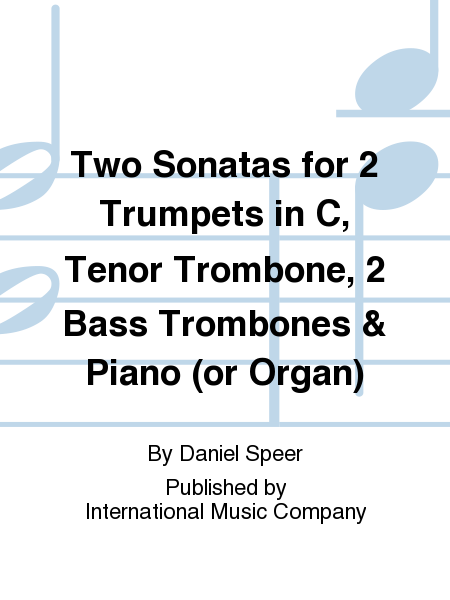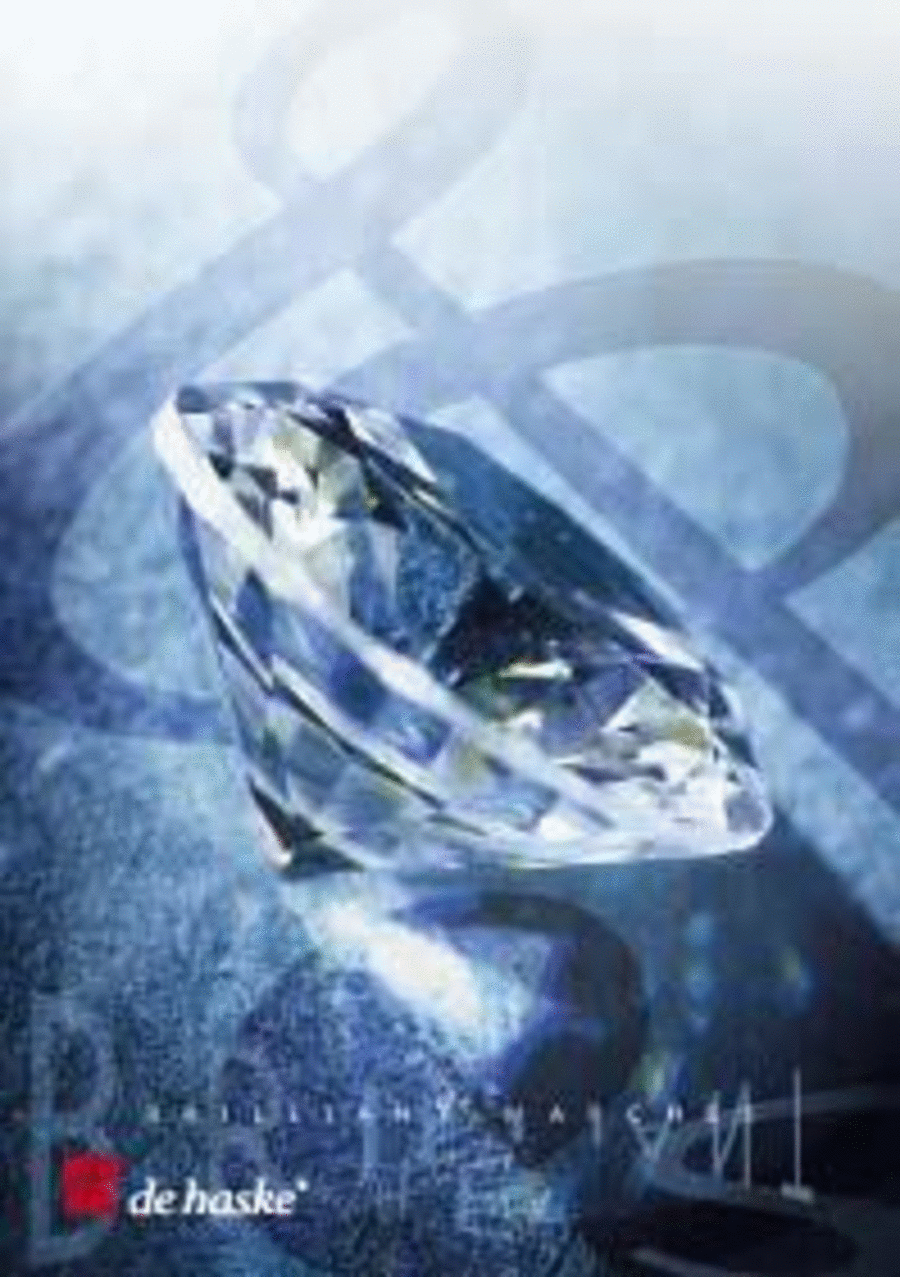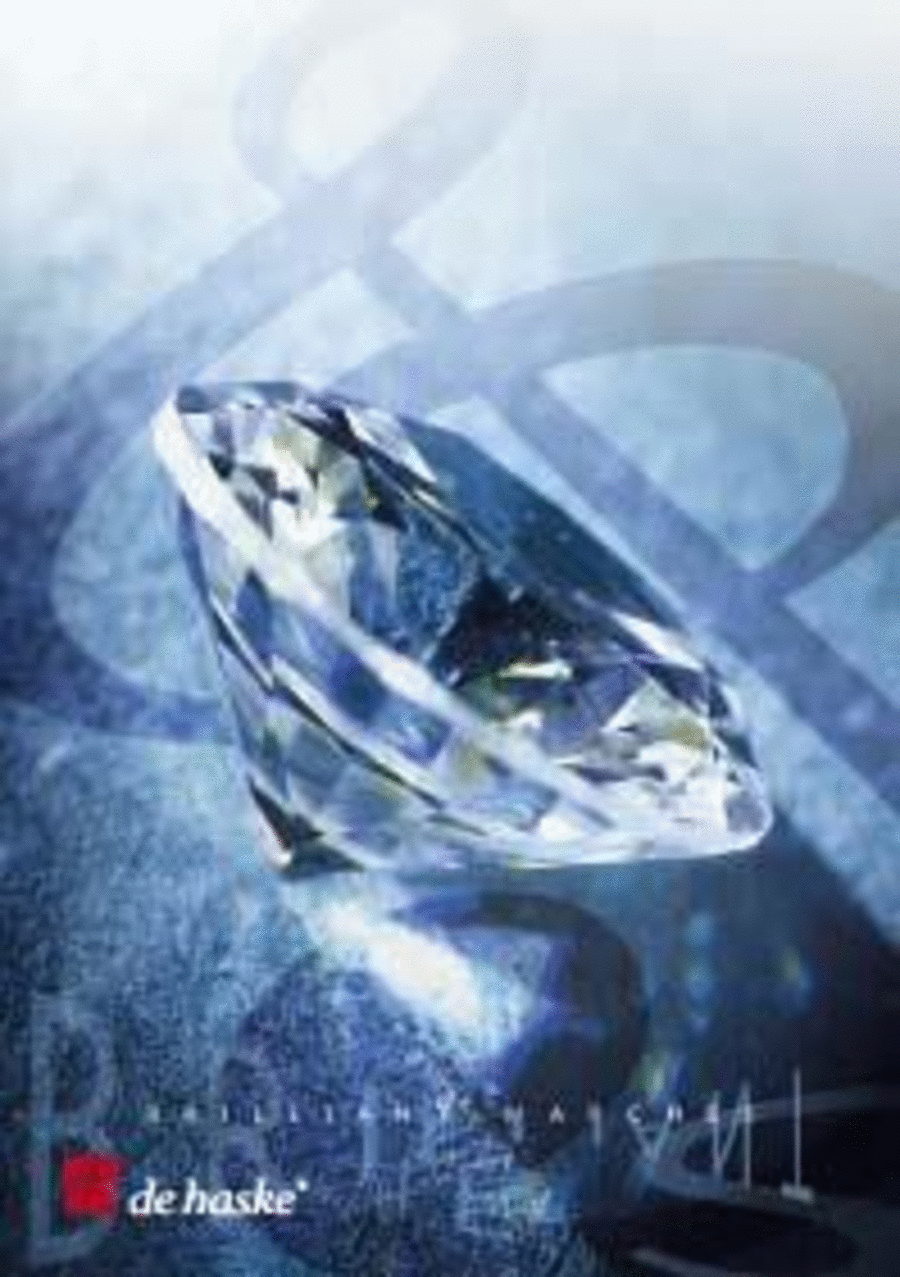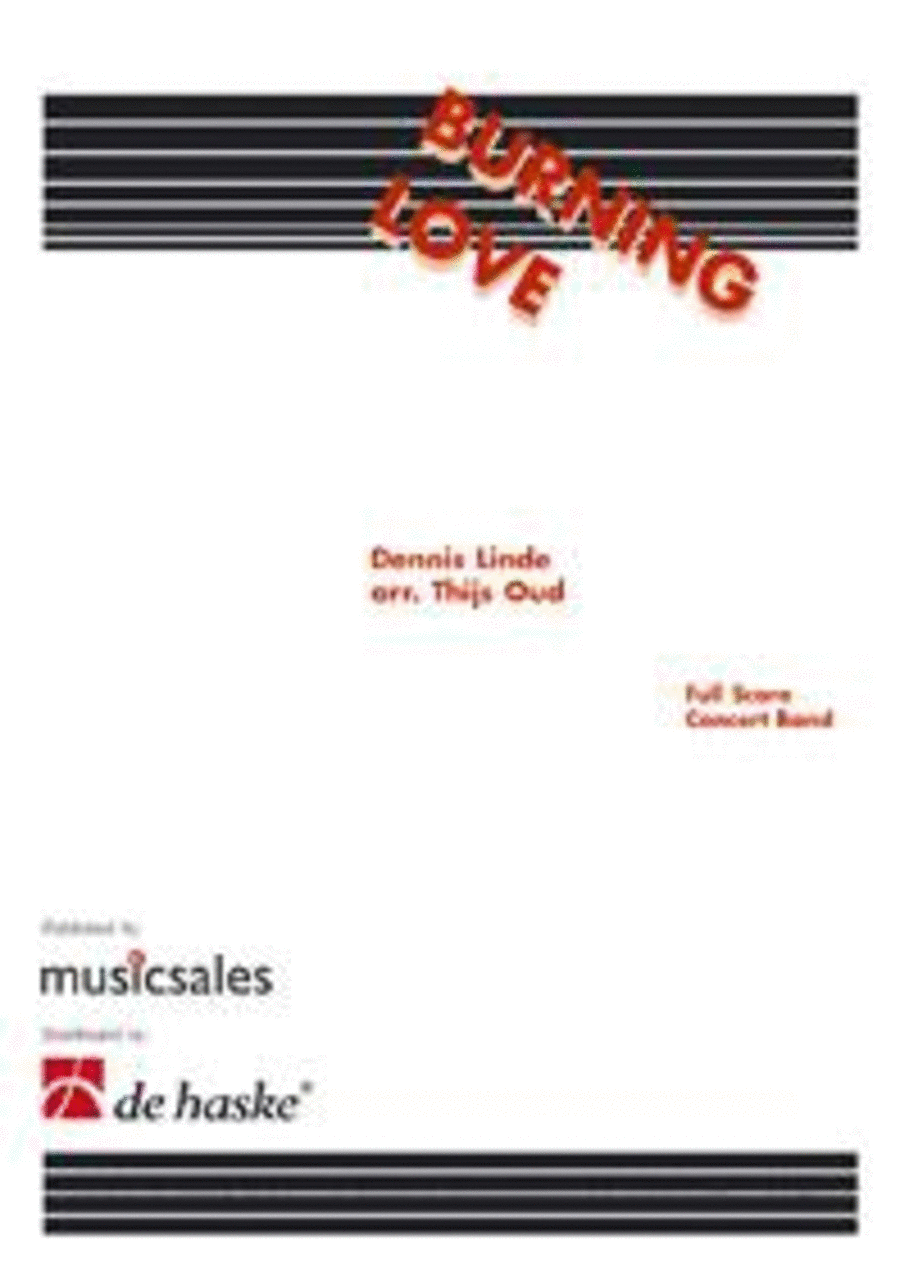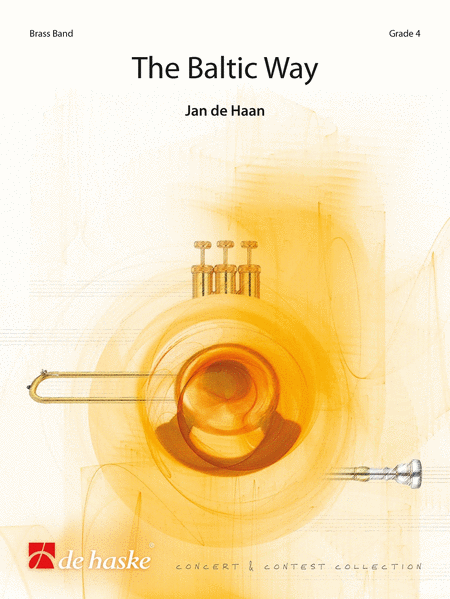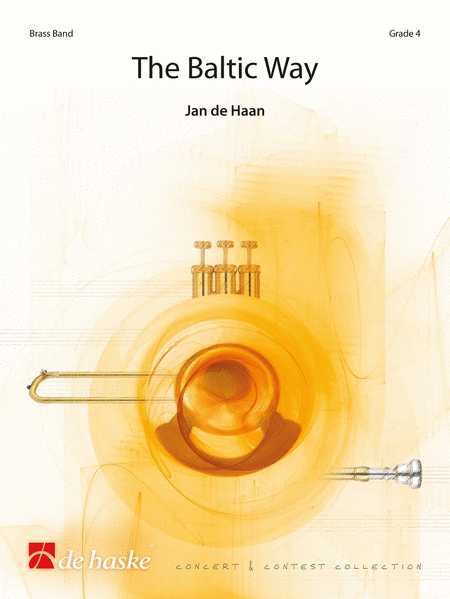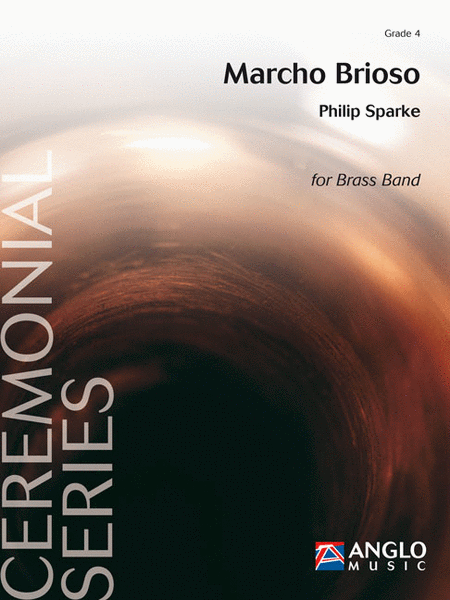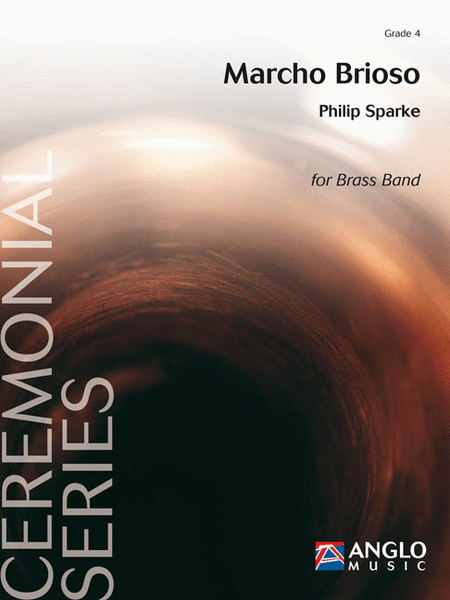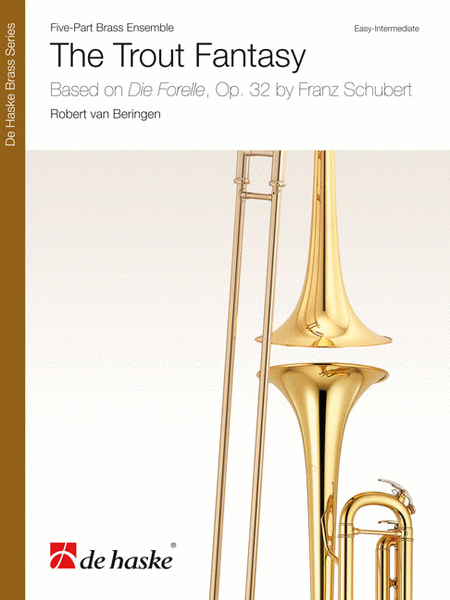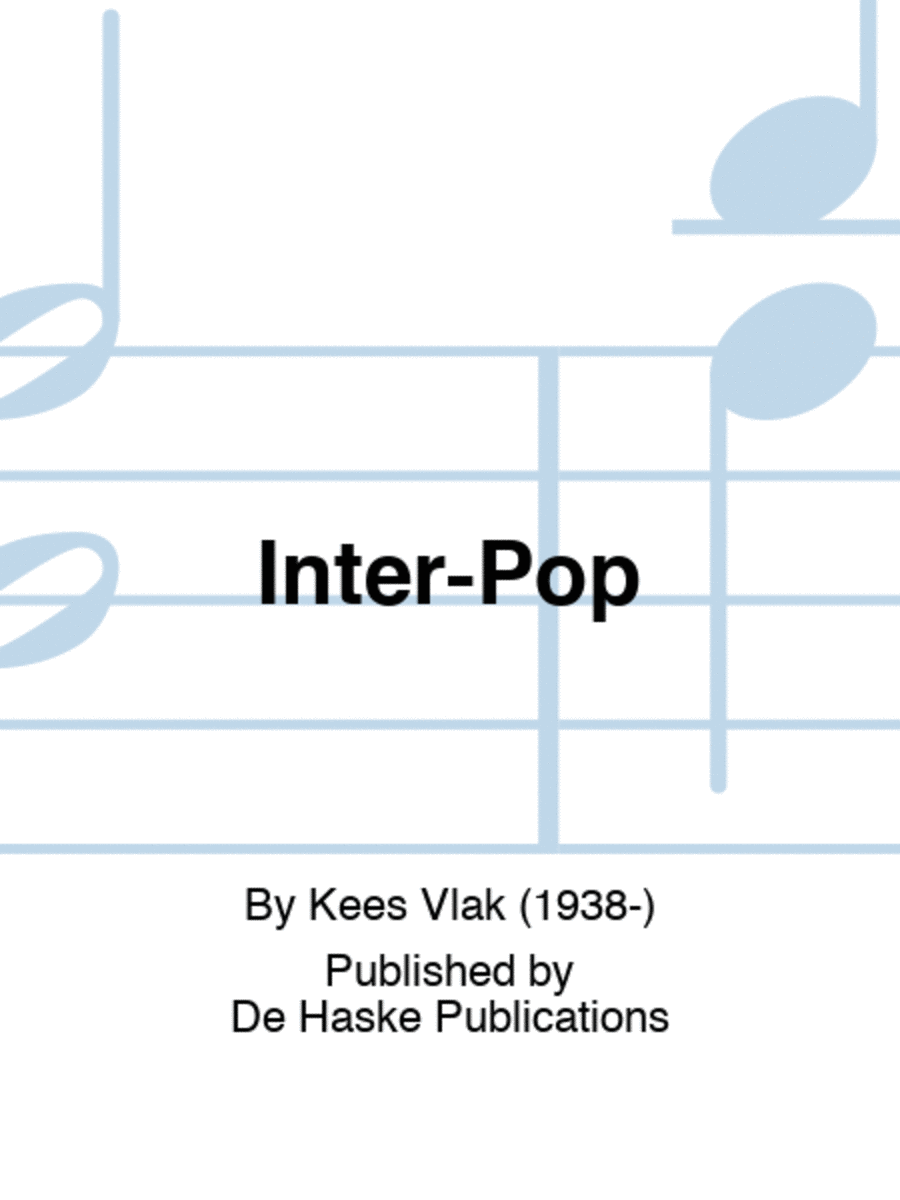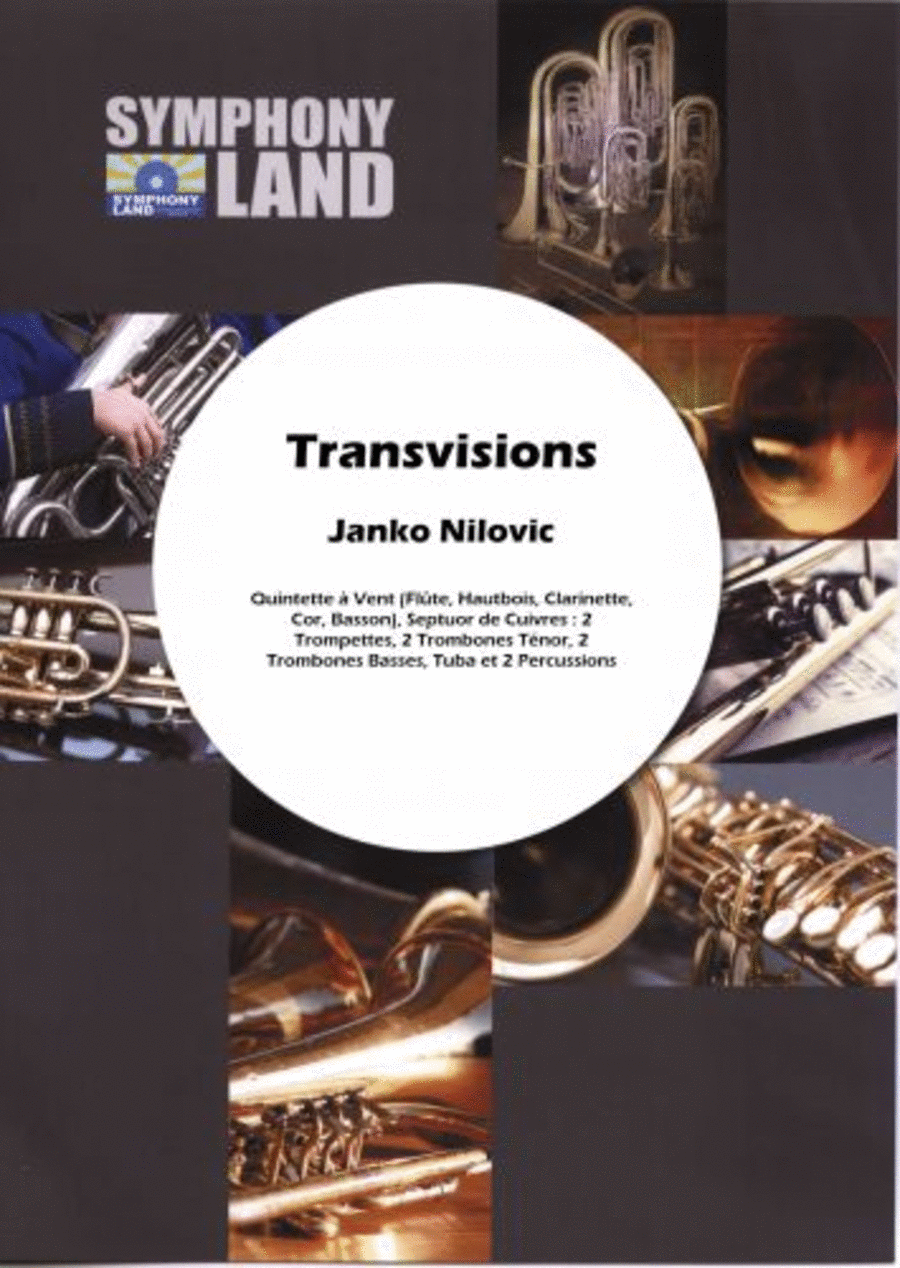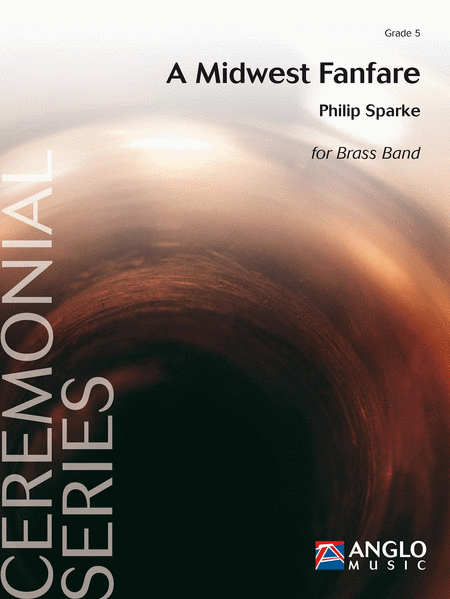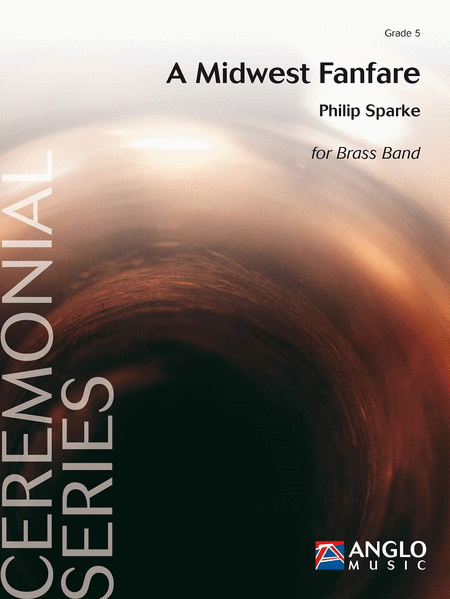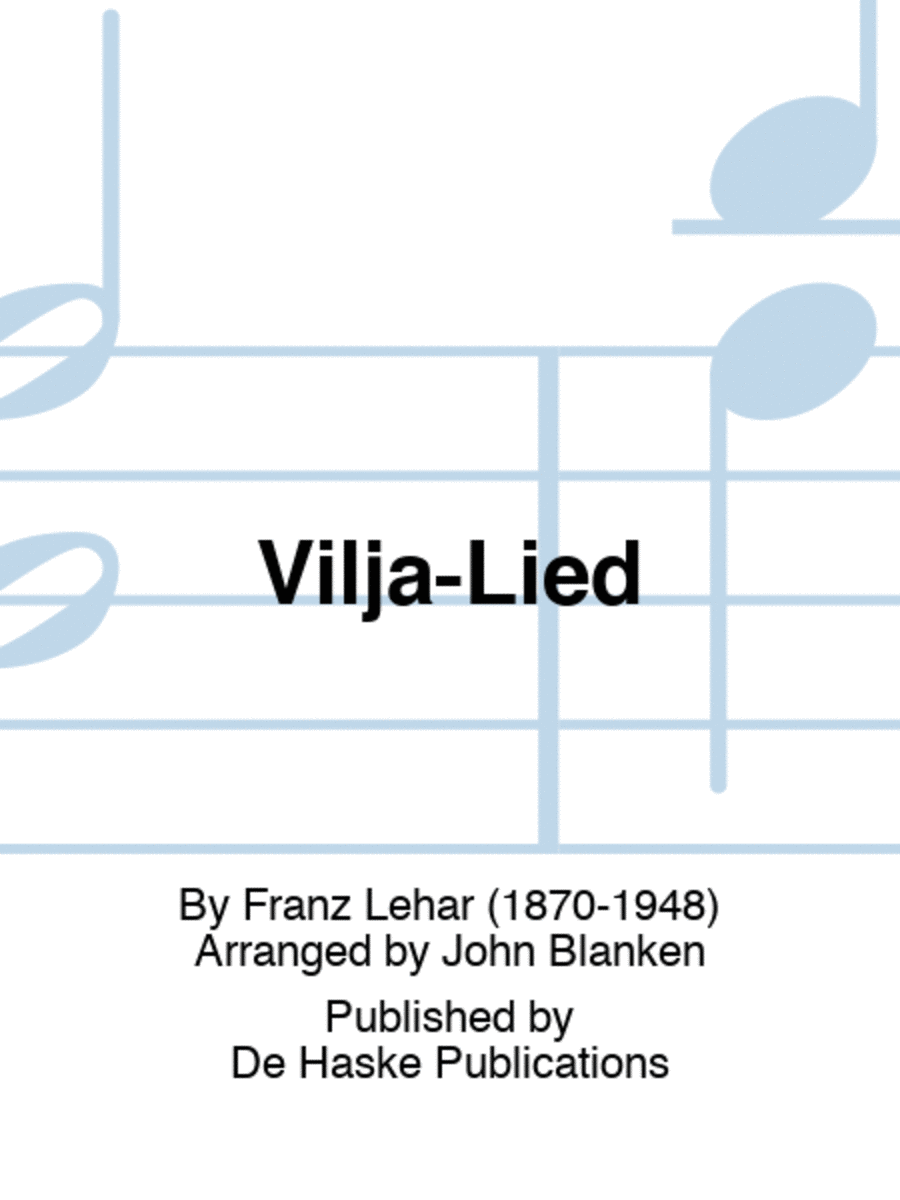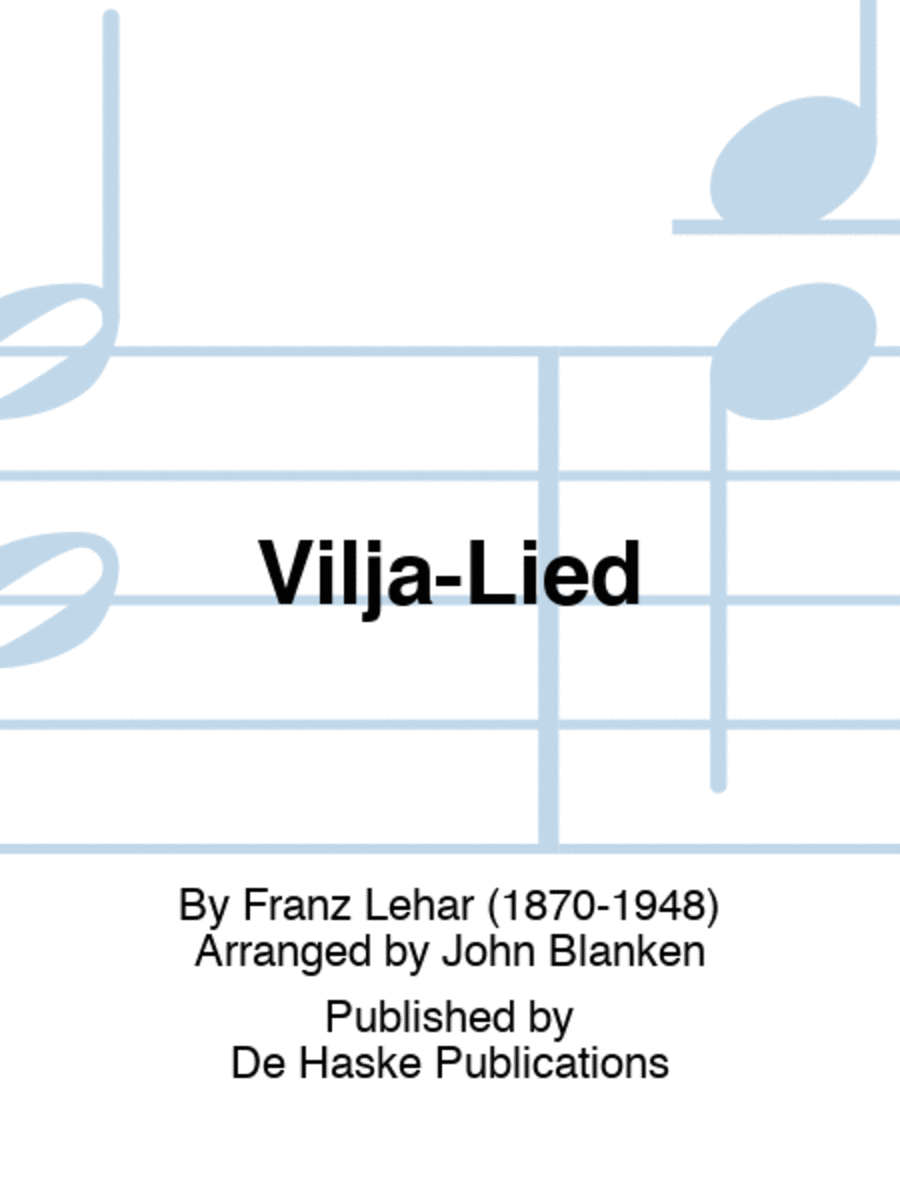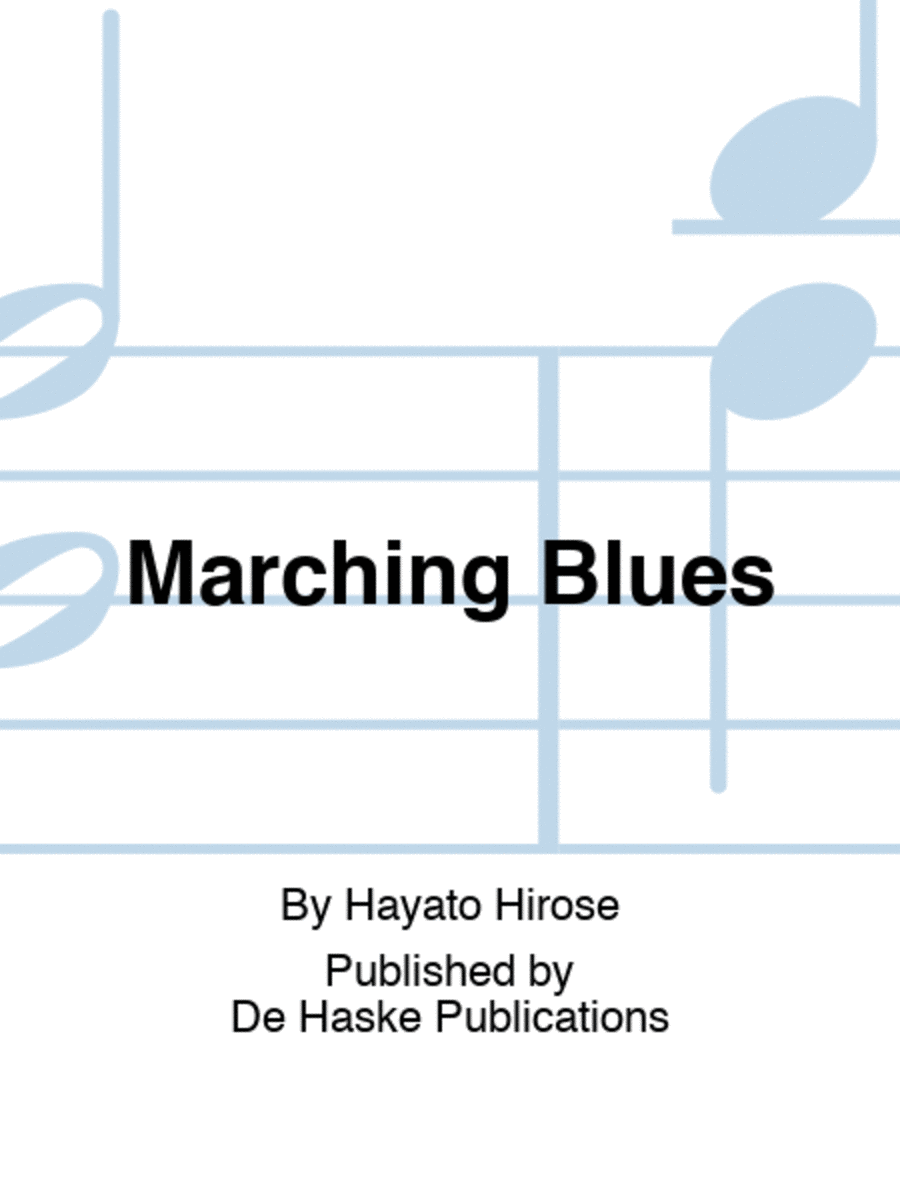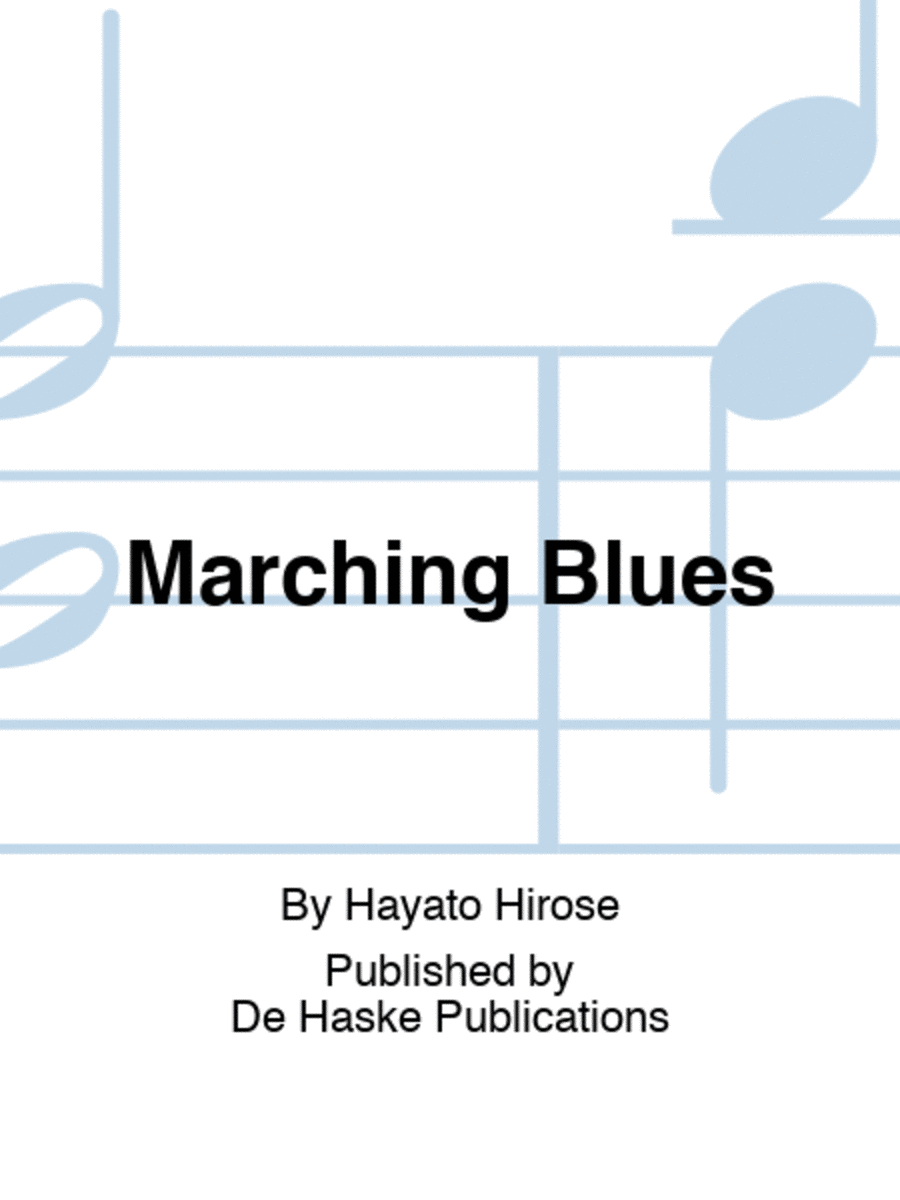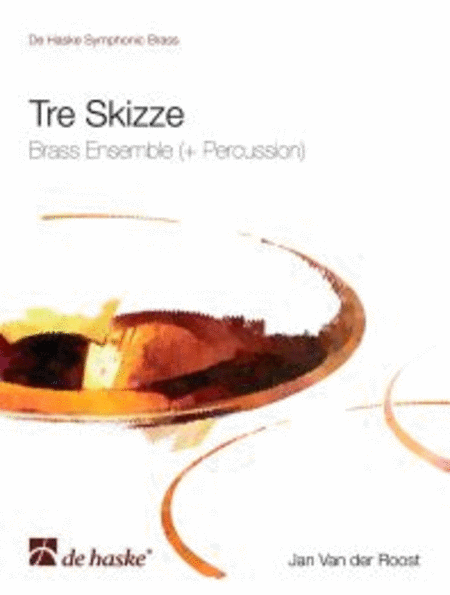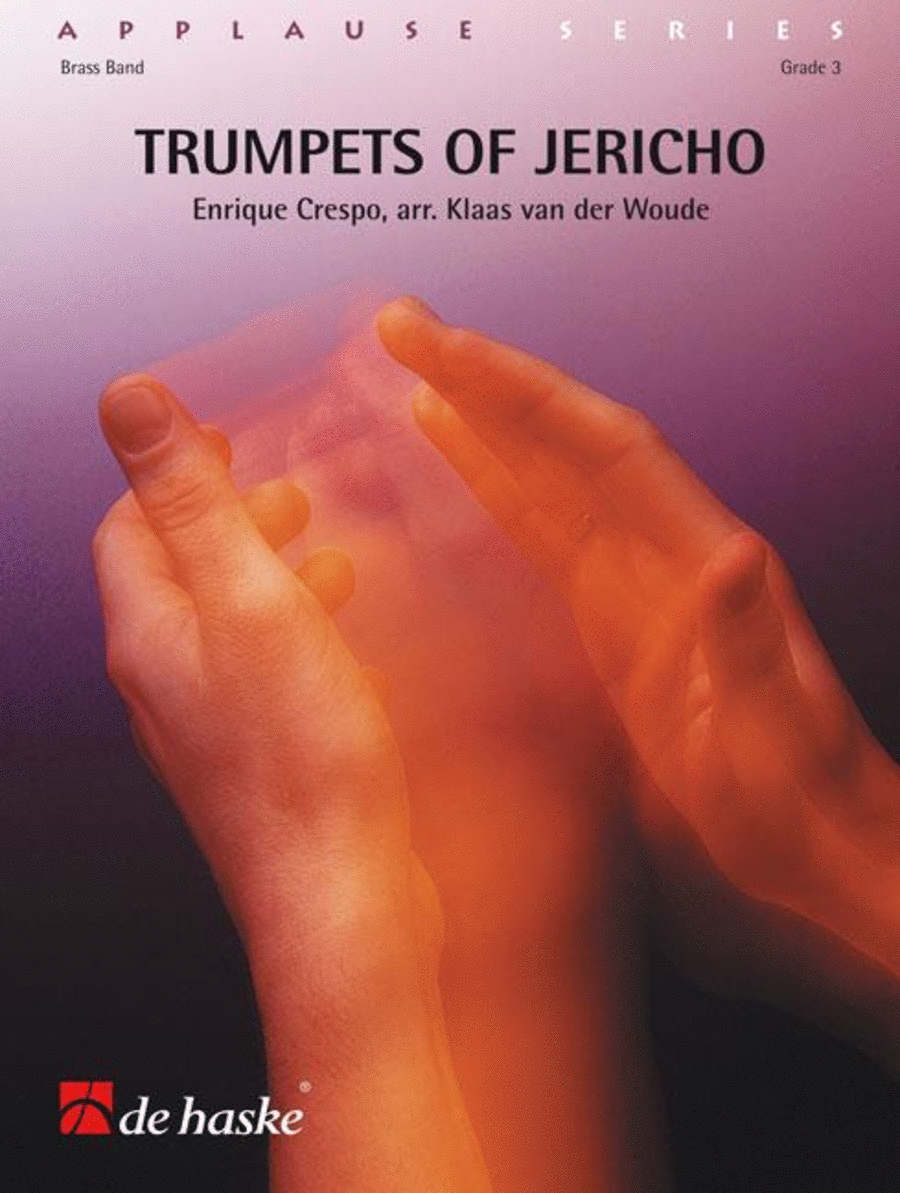|
| Big Fun on the Bass Drum
Ensemble de cuivres [Conducteur et Parties séparées]
Gobelin Music Publications
Brass Band - easy SKU: BT.GOB-000789-030 Composed by William Vean. Set (S...(+)
Brass Band - easy SKU:
BT.GOB-000789-030
Composed by William Vean.
Set (Score & Parts).
Gobelin Music
Publications #GOB
000789-030. Published by
Gobelin Music
Publications
(BT.GOB-000789-030).
Beating a drum
is fun. Beating a big
drum is even more fun.
Being a soloist and
beating a bass drum is
best of all.
In
'Big Fun on the Bass
Drum' the dream of every
starter percussionist is
realized.
He/she is
soloist and is allowed to
really beat the drum hard
without the conductor
putting a stop to it, but
beware: a new skin is
rather expensive.
'Big Fun on the Bass
Drum' is not only about
hitting as hard as you
can, though.
A lot of
attention is paid to
playing the bass drum
very softly. And what is
more, the composer has
found room to offer the
soloist a real cadenza -
at this point in the
composition he/she can
either play the
partprescribed or give
the audience an
improvisation of his/her
own.
Slaan op een
trom is leuk. Slaan op
een grote trom is nog
leuker, maar 'top of the
bill' is solist zijn op
een grote trom!
In Big fun on the Bass
Drum komt de droom van
elke beginnende
slagwerker
uit.
Hij/zij mag zo
hardals mogelijk slaan,
zonder 'lastig'te worden
gevallen door een
dirigent, maar let op:
een nieuw vel is
duur!
Maar er wordt
niet alleen aandacht
besteed aan hard meppen
in Big Fun on the Bass
Drum, ook de zachte
passages krijgenruim
aandacht.
Verder laat
componist William Vean
ruimte voor de solist(e)
zijn/haar kunnen te tonen
in een heuse cadens! $70.95 - Voir plus => AcheterDélais: 4 to 6 weeks | | | |
| Big Fun on the Bass Drum
Ensemble de cuivres [Conducteur]
Gobelin Music Publications
Brass Band - easy SKU: BT.GOB-000789-130 Composed by William Vean. Score ...(+)
Brass Band - easy SKU:
BT.GOB-000789-130
Composed by William Vean.
Score Only. Gobelin Music
Publications #GOB
000789-130. Published by
Gobelin Music
Publications
(BT.GOB-000789-130).
Beating a drum
is fun. Beating a big
drum is even more fun.
Being a soloist and
beating a bass drum is
best of all.
In
'Big Fun on the Bass
Drum' the dream of every
starter percussionist is
realized.
He/she is
soloist and is allowed to
really beat the drum hard
without the conductor
putting a stop to it, but
beware: a new skin is
rather expensive.
'Big Fun on the Bass
Drum' is not only about
hitting as hard as you
can, though.
A lot of
attention is paid to
playing the bass drum
very softly. And what is
more, the composer has
found room to offer the
soloist a real cadenza -
at this point in the
composition he/she can
either play the
partprescribed or give
the audience an
improvisation of his/her
own.
Slaan op een
trom is leuk. Slaan op
een grote trom is nog
leuker, maar 'top of the
bill' is solist zijn op
een grote trom!
In Big fun on the Bass
Drum komt de droom van
elke beginnende
slagwerker
uit.
Hij/zij mag zo
hardals mogelijk slaan,
zonder 'lastig'te worden
gevallen door een
dirigent, maar let op:
een nieuw vel is
duur!
Maar er wordt
niet alleen aandacht
besteed aan hard meppen
in Big Fun on the Bass
Drum, ook de zachte
passages krijgenruim
aandacht.
Verder laat
componist William Vean
ruimte voor de solist(e)
zijn/haar kunnen te tonen
in een heuse cadens! $16.95 - Voir plus => AcheterDélais: 2 to 3 weeks | | | |
| Mombassa Beat
Ensemble de cuivres [Conducteur] - Débutant
Gobelin Music Publications
Brass Band - Grade 1.5 SKU: BT.GOB-000701-130 Composed by Peter Martin. S...(+)
Brass Band - Grade 1.5
SKU:
BT.GOB-000701-130
Composed by Peter Martin.
Score Only. 8 pages.
Gobelin Music
Publications #GOB
000701-130. Published by
Gobelin Music
Publications
(BT.GOB-000701-130).
A contagious
piece of music by Peter
Martin in which he hints
at the popular amusement
music by Bert Kaempfert.
Mombassa is a lively
harbour city in Kenya
which can be heard in the
music. Happiness and
cheeriness are the
ingredients of this nice
piece. Success is
assured.
Erg
aanstekelijk muziekwerkje
van Peter Martin waarin
hij knipoogt naar de
populaire
amusementsmuziek van Bert
Kaempfert.
Mombassa
is een levendige
havenstad in Kenia en dat
is te merken. Vrolijkheid
en opgewektheid zijn de
ingrediëntenvan dit
fraaie werkje dat succes
garandeert. $12.95 - Voir plus => AcheterDélais: 2 to 3 weeks | | | |
| Mombassa Beat
Ensemble de cuivres [Conducteur et Parties séparées] - Débutant
Gobelin Music Publications
Brass Band - Grade 1.5 SKU: BT.GOB-000701-030 Composed by Peter Martin. S...(+)
Brass Band - Grade 1.5
SKU:
BT.GOB-000701-030
Composed by Peter Martin.
Set (Score & Parts). 30
pages. Gobelin Music
Publications #GOB
000701-030. Published by
Gobelin Music
Publications
(BT.GOB-000701-030).
A contagious
piece of music by Peter
Martin in which he hints
at the popular amusement
music by Bert Kaempfert.
Mombassa is a lively
harbour city in Kenya
which can be heard in the
music. Happiness and
cheeriness are the
ingredients of this nice
piece. Success is
assured.
Erg
aanstekelijk muziekwerkje
van Peter Martin waarin
hij knipoogt naar de
populaire
amusementsmuziek van Bert
Kaempfert.
Mombassa
is een levendige
havenstad in Kenia en dat
is te merken. Vrolijkheid
en opgewektheid zijn de
ingrediëntenvan dit
fraaie werkje dat succes
garandeert. $70.95 - Voir plus => AcheterDélais: 4 to 6 weeks | | | |
| Two Sonatas for 2 Trumpets in C, Tenor Trombone, 2 Bass Trombones and Piano (or Organ)
Ensemble de cuivres
IMC (International Music Co.)
By Daniel Speer. Edited by Keith Brown. For 2 trumpets in C, tenor trombone, 2 b...(+)
By Daniel Speer. Edited
by Keith Brown. For 2
trumpets in C, tenor
trombone, 2 bass
trombones and piano (or
organ). Published by
International Music
Company
$14.50 - Voir plus => AcheterDélais: 1 to 2 weeks | | | |
| Liberty
Ensemble de cuivres [Conducteur et Parties séparées] - Intermédiaire
De Haske Publications
Brass Band - Grade 4 SKU: BT.DHP-1064075-030 Composed by John Blanken. Br...(+)
Brass Band - Grade 4
SKU:
BT.DHP-1064075-030
Composed by John Blanken.
Brilliant Marches. March.
Set (Score & Parts).
Composed 2006. De Haske
Publications #DHP
1064075-030. Published by
De Haske Publications
(BT.DHP-1064075-030).
9x12 inches.
English-German-Dutch.
The traditional
concert march
Liberty, was
composed in 2004 for the
brass band Euphonia from
Wolvega, the Netherlands.
Your band will feel truly
liberated with this
lively composition.
Liberty is
gecomponeerd in een
traditionele marsvorm.
Het eerste deel bevat
naast een beweeglijk
thema een aansprekende
bassolo. Na de bassolo
komt het eerste thema
weer naar voren en wordt,
na een krachtige
afsluiting, hettrio
ingeleid. Een lange,
lyrische melodie in de
tenorgroep laat
vervolgens het publiek
even achteroverleunen en
genieten. Ze wordt echter
bruusk onderbroken door
een wilde
fortissimopassage,
gekenmerkt door een lange
toonladderdie door het
hele orkest heen loopt.
Deze mondt uit in een
welluidend Grandioso met
een herhaling van de
lyrische melodie,
omspeeld in de discant,
waarmee Liberty
besluit.
In
Liberty wird ein
lebhaftes Thema im ersten
Teil von einem
anspruchsvollen Solo
für den Bass und die
gesamte Brass Band
abgelöst. Nach dem
Trio mit einer
ausgesprochen lyrischen
Melodie und heftigen
Fortissimo-Passagen
beendet ein reizvolles
Grandioso dieses
Stück, das in
traditioneller Marschform
geschrieben, aber alles
andere als gewöhnlich
ist.
Liberty
est une marche
contrastante de forme
traditionnelle. La
première partie
développe un thème
pétillant qui se fond
dans un solo de basse
solidement charpenté.
Le trio, plus lyrique,
expose quelques nouvelles
idées formant un
contraste marqué avec
le passage
d’ouverture. La
musique s’enflamme
pour un énoncé en
fortissimo qui
chemine travers
l’ensemble de
l’orchestre puis
cède sa place un
thème
Grandioso, dernier
épisode de
l’œuvre. $78.95 - Voir plus => AcheterDélais: 2 to 3 weeks | | | |
| Liberty
Ensemble de cuivres [Conducteur] - Intermédiaire
De Haske Publications
Brass Band - Grade 4 SKU: BT.DHP-1064075-130 Composed by John Blanken. Br...(+)
Brass Band - Grade 4
SKU:
BT.DHP-1064075-130
Composed by John Blanken.
Brilliant Marches. March.
Score Only. Composed
2006. De Haske
Publications #DHP
1064075-130. Published by
De Haske Publications
(BT.DHP-1064075-130).
9x12 inches.
English-German-Dutch.
The traditional
concert march
Liberty, was
composed in 2004 for the
brass band Euphonia from
Wolvega, the Netherlands.
Your band will feel truly
liberated with this
lively composition.
Liberty is
gecomponeerd in een
traditionele marsvorm.
Het eerste deel bevat
naast een beweeglijk
thema een aansprekende
bassolo. Na de bassolo
komt het eerste thema
weer naar voren en wordt,
na een krachtige
afsluiting, hettrio
ingeleid. Een lange,
lyrische melodie in de
tenorgroep laat
vervolgens het publiek
even achteroverleunen en
genieten. Ze wordt echter
bruusk onderbroken door
een wilde
fortissimopassage,
gekenmerkt door een lange
toonladderdie door het
hele orkest heen loopt.
Deze mondt uit in een
welluidend Grandioso met
een herhaling van de
lyrische melodie,
omspeeld in de discant,
waarmee Liberty
besluit.
In
Liberty wird ein
lebhaftes Thema im ersten
Teil von einem
anspruchsvollen Solo
für den Bass und die
gesamte Brass Band
abgelöst. Nach dem
Trio mit einer
ausgesprochen lyrischen
Melodie und heftigen
Fortissimo-Passagen
beendet ein reizvolles
Grandioso dieses
Stück, das in
traditioneller Marschform
geschrieben, aber alles
andere als gewöhnlich
ist.
Liberty
est une marche
contrastante de forme
traditionnelle. La
première partie
développe un thème
pétillant qui se fond
dans un solo de basse
solidement charpenté.
Le trio, plus lyrique,
expose quelques nouvelles
idées formant un
contraste marqué avec
le passage
d’ouverture. La
musique s’enflamme
pour un énoncé en
fortissimo qui
chemine travers
l’ensemble de
l’orchestre puis
cède sa place un
thème
Grandioso, dernier
épisode de
l’œuvre. $24.95 - Voir plus => AcheterDélais: 2 to 3 weeks | | | |
| Burning Love
Ensemble de cuivres [Conducteur] - Facile
Music Sales
Brass Band - Grade 3 SKU: BT.1342-06-130-MS Composed by Dennis Linde. Arr...(+)
Brass Band - Grade 3
SKU:
BT.1342-06-130-MS
Composed by Dennis Linde.
Arranged by Thijs Oud.
Scherzando Pop, Film and
Show. Pop & Rock. Score
Only. Composed 2006. 24
pages. Music Sales
#1342-06-130 MS.
Published by Music Sales
(BT.1342-06-130-MS).
9x12 inches.
English-German-French-Dut
ch. In the
seventies, Elvis Presley
gave many concerts with
an orchestra that
included a large wind
section. These concerts
were characterised by
enthusiasm and a fast
tempo. Burning
Love was one of the
up-tempo numbers where
the bass guitar player
played an especially
important role. The
cornets and the trombones
can play standing behind
the band adding to the
visual and dynamic
enhancement.
Elvis Presley gab
in den siebziger Jahren
viele Konzerte, auf denen
er sich von einem
großen Orchester mit
zahlreichen Bläsern
begleiten ließ. Ein
hohes Tempo und absolut
mitreißende
Begeisterung
kennzeichneten diese
Auftritte. Eine der
beliebten schnellen
Nummern war Burning
Love, in dem die
Bassgitarre eine wichtige
Rolle spielte. So ist
denn auch Thijs Ouds
gelungene Bearbeitung von
Burning Love eine
besondere Herausforderung
für das tiefe
Register, während die
Trompeten und Posaunen
die ursprünglichen
Bläserstimmen
übernehmen.
Dan
s les années 1970,
Elvis Presley
s’est produit,
plusieurs reprises, avec
un orchestre disposant
d’une grande
section
d’instruments
vent. Caractéristiques
de ces concerts : un
débordement
d’enthousiasme et
une énergie intense.
Burning Love est
l’une de ces
chansons au rythme
enlevé où la
guitare basse joue un
rôle
particulièrement
important. Cet
arrangement de Thijs Oud
ne laissera personne de
marbre. $23.95 - Voir plus => AcheterDélais: 2 to 3 weeks | | | |
| The Baltic Way
Ensemble de cuivres [Conducteur] - Intermédiaire
De Haske Publications
Brass Band - Grade 4 SKU: BT.DHP-1206253-130 Composed by Jan de Haan. Con...(+)
Brass Band - Grade 4
SKU:
BT.DHP-1206253-130
Composed by Jan de Haan.
Concert and Contest
Collection Brass Band en
Fanfare. Concert Piece.
Score Only. Composed
2019. 48 pages. De Haske
Publications #DHP
1206253-130. Published by
De Haske Publications
(BT.DHP-1206253-130).
English-German-French-
Dutch. In 1989, the
demonstration named the
Baltic Way also
known as the Baltic
Chain— was held in
the Baltic states of
Estonia, Latvia and
Lithuania by its citizens
in a call for
independence from the
Soviet Union. On 23rd
August 1989, some two
million participants
formed a human chain,
hand-in-hand all the way
from the Estonian capital
of Tallinn its Latvian
counterpart, Riga,
through to the Lithuanian
capital of Vilnius - six
hundred kilometres long.
It became the longest
human chain ever created
and turned out to be the
final push needed for
much sought-after
independence. This
historic event became the
source of inspiration for
this composition. The
introduction of thefirst
movement, ‘Struggle
for Independence’,
is based on a nocturne
for piano by the renowned
Lithuanian composer and
painter Mikalojus
Konstantinas iurlionis
(1875-1911), thematic
material from which has
been incorporated
throughout the whole
composition. The
melancholic beginning is
followed by a powerful
theme which reflects the
resolve of the Baltic
people. The sudden
aggressive, dissonant
chords and a dominant
and—in rhythmic
terms—contrary
bass drum announce that
the resistance is not
going smoothly. Just for
a moment, we hear the
anthem of the Soviet
Union in the lower brass,
but this is relentlessly
pushed to the background
by the rest of the band
playing the Lithuanian
national anthem,
‘Tautiška giesm
’ (Lithuania, our
homeland). The second
movement, ‘Decades
of Suffering’,
echoes life under the
Soviet Union's thumb. In
the pursuit of
independence, a peaceful
protest is planned in
which a human chain is
formed across the Baltic
states of Estonia, Latvia
and Lithuania. This
‘Chain of
Freedom’ is
depicted in the final
movement of the work.
De Baltische Weg
(The Baltic Way)
was een demonstratie van
de bevolking van de
Baltische staten die in
1989 plaatsvond als een
roep om onafhankelijkheid
van de Sovjet-Unie. Deze
historische gebeurtenis
vormde de inspiratiebron
voor deze compositie. Van
Vilnius via Riga naar
Tallinn werd een
zeshonderd kilometer
lange keten van naar
schatting twee miljoen
mensen gevormd. Op 23
augustus 1989 gaven al
die mensen elkaar de hand
en werd De Baltische Weg
de langste menselijke
keten ooit. Het bleek de
uiteindelijke opmaat tot
de zo gewenste
onafhankelijkheid. De
inleiding van het eerste
deel, ‘Struggle for
Independence’, is
gebaseerd op een nocturne
voor piano van
devooraanstaande Litouwse
componist en
kunstschilder Mikalojus
Konstantinas iurlionis
(1875-1911). Het
thematische materiaal van
deze nocturne is door de
hele compositie heen
verwerkt. Na het
melancholische begin
volgt een krachtig thema,
waarmee de strijdbaarheid
van de Baltische
bevolking wordt
uitgebeeld. De
plotselinge agressieve
dissonante akkoorden en
een dominante en ritmisch
gezien tegendraadse grote
trom laten horen dat het
verzet niet eenvoudig
verloopt. Even klinkt het
begin van het volkslied
van de Sovjet-Unie in het
lage koper, maar dat
wordt door de rest van de
band onverbiddelijk naar
de achtergrond verwezen
door het Litouwse
nationale volkslied
‘Tautiška giesm
’ (Litouwen, ons
vaderland). In deel twee,
‘Decades of
Suffering’, wordt
het leven onder het juk
van de Sovjet-Unie
verklankt. In het streven
naar onafhankelijkheid
worden plannen gemaakt om
als vreedzaam protest
tegen de onderdrukking
een menselijke keten te
vormen over de wegen van
de Baltische staten
Litouwen, Letland en
Estland. Deze
‘Chain of
Freedom’ wordt in
het laatste deel van het
werk muzikaal
weergegeven.
Der
sogenannte Baltischer Weg
(The Baltic Way)
auch unter dem Namen
Baltische Kette bekannt
war 1989 eine
Demonstration von
Bürgern in den
baltischen Staaten
Estland, Lettland und
Litauen mit dem Aufruf
zur Unabhängigkeit von
der Sowjetunion. Am 23.
August 1989 bildeten rund
zwei Millionen Teilnehmer
eine sechshundert
Kilometer lange
Menschenkette, die von
der estnischen Hauptstadt
Tallinn über das
lettische Riga bis zur
litauischen Hauptstadt
Vilnius reichte. Die
längste Menschenkette,
die jemals geschaffen
wurde, erwies sich als
der letzte Schritt, der
zur lang ersehnten
Unabhängigkeit
führte. Dieses
historische Ereignis
diente der Komposition
alsInspirationsquelle.
Die Einleitung des ersten
Satzes, Struggle for
Independence“,
basiert auf einem
Nocturne für Klavier
des bekannten litauischen
Komponisten und Malers
Mikalojus Konstantinas
iurlionis (1875 1911),
dessen thematisches
Material in der gesamten
Komposition verwendet
wird. Dem melancholischen
Anfang folgt ein
mitreißendes Thema,
das die Entschlossenheit
der baltischen
Bevölkerung
widerspiegelt. Die
plötzlichen
aggressiven, dissonanten
Akkorde und eine
dominante und rhythmisch
gegenläufige Bewegung
in der Basstrommel
kündigen an, dass der
Widerstand nicht
reibungslos verläuft.
Für einen kurzen
Moment erklingt die Hymne
der Sowjetunion in den
tiefen Blechbläsern,
aber diese wird
unerbittlich vom
restlichen Orchester in
den Hintergrund
gedrängt, welches die
litauische Nationalhymne
Tautiška giesm “
(Litauen, unser
Heimatland“)
spielt. Der zweite Satz,
Decades of
Suffering“,
spiegelt das Leben unter
dem Joch der Sowjetunion
wider. Für das Streben
nach Unabhängigkeit
war ein friedlicher
Protest geplant, bei dem
eine Menschenkette durch
die baltischen Staaten
Estland, Lettland und
Litauen gebildet wurde.
Diese Chain of
Freedom“ wird im
letzten Satz des Werkes
beschrieben.
En
1989, la manifestation
nommée « La Voie
balte » (The Baltic
Way) s’est
tenue en Estonie, en
Lettonie et en Lituanie,
les pays baltes dont les
citoyens demandaient
être indépendants
de l’Union
soviétique. Le 23 ao t
1989, quelque deux
millions de personnes se
tenant par la main ont
formé une chaîne
humaine de 600 km de long
reliant les trois
capitales Tallinn
(Estonie), Riga
(Lettonie) et Vilnius
(Lituanie). Cette
chaîne humaine, la
plus longue ce jour,
donna une impulsion
décisive au
rétablissement
d’une
indépendance vivement
souhaitée. Cet
événement
historique est devenu
source
d’inspiration pour
cette composition.
L’introduction du
premier mouvement,«
Struggle for Independence
», est fondée sur
un nocturne pour piano du
célèbre compositeur
et peintre letton
Mikalojus Konstantinas
iurlionis (1875-1911). Du
matériel thématique
emprunté ce nocturne
est parsemé travers la
présente composition.
Un début
mélancolique est suivi
d’un thème
puissant qui reflète
la détermination des
peuples baltes. La
présence soudaine
d’accords
agressifs et dissonants,
associés une grosse
caisse dont le
décalage rythmique
domine, indiquent que la
résistance rencontre
des obstacles. Nous
entendons
momentanément
l’hymne
soviétique dans les
cuivres graves, mais cet
air est inexorablement
repoussé
l’arrière-plan
par le reste de
l’orchestre
interprétant
l’hymne national
de Lettonie, «
Tautiška giesm »
(Lettonie, notre patrie).
Le deuxième mouvement,
« Decades of Suffering
», dépeint la vie
sous le joug de
l’Union
soviétique. la
recherche de
l’indépendance,
une manifestation
pacifique est
organisée sous la
forme d’une
chaîne humaine
traversant les trois pays
baltes l ’Estonie,
la Lettonie et la
Lituanie. Le dernier
mouvement de la pièce,
« Chain of Freedom
», exprime cet appel
la liberté. $30.95 - Voir plus => AcheterDélais: 2 to 3 weeks | | | |
| The Baltic Way
Ensemble de cuivres [Conducteur et Parties séparées] - Intermédiaire
De Haske Publications
Brass Band - Grade 4 SKU: BT.DHP-1206253-030 Composed by Jan de Haan. Con...(+)
Brass Band - Grade 4
SKU:
BT.DHP-1206253-030
Composed by Jan de Haan.
Concert and Contest
Collection Brass Band en
Fanfare. Concert Piece.
Set (Score & Parts).
Composed 2019. De Haske
Publications #DHP
1206253-030. Published by
De Haske Publications
(BT.DHP-1206253-030).
English-German-French-
Dutch. In 1989, the
demonstration named the
Baltic Way also
known as the Baltic
Chain— was held in
the Baltic states of
Estonia, Latvia and
Lithuania by its citizens
in a call for
independence from the
Soviet Union. On 23rd
August 1989, some two
million participants
formed a human chain,
hand-in-hand all the way
from the Estonian capital
of Tallinn its Latvian
counterpart, Riga,
through to the Lithuanian
capital of Vilnius - six
hundred kilometres long.
It became the longest
human chain ever created
and turned out to be the
final push needed for
much sought-after
independence. This
historic event became the
source of inspiration for
this composition. The
introduction of thefirst
movement, ‘Struggle
for Independence’,
is based on a nocturne
for piano by the renowned
Lithuanian composer and
painter Mikalojus
Konstantinas iurlionis
(1875-1911), thematic
material from which has
been incorporated
throughout the whole
composition. The
melancholic beginning is
followed by a powerful
theme which reflects the
resolve of the Baltic
people. The sudden
aggressive, dissonant
chords and a dominant
and—in rhythmic
terms—contrary
bass drum announce that
the resistance is not
going smoothly. Just for
a moment, we hear the
anthem of the Soviet
Union in the lower brass,
but this is relentlessly
pushed to the background
by the rest of the band
playing the Lithuanian
national anthem,
‘Tautiška giesm
’ (Lithuania, our
homeland). The second
movement, ‘Decades
of Suffering’,
echoes life under the
Soviet Union's thumb. In
the pursuit of
independence, a peaceful
protest is planned in
which a human chain is
formed across the Baltic
states of Estonia, Latvia
and Lithuania. This
‘Chain of
Freedom’ is
depicted in the final
movement of the work.
De Baltische Weg
(The Baltic Way)
was een demonstratie van
de bevolking van de
Baltische staten die in
1989 plaatsvond als een
roep om onafhankelijkheid
van de Sovjet-Unie. Deze
historische gebeurtenis
vormde de inspiratiebron
voor deze compositie. Van
Vilnius via Riga naar
Tallinn werd een
zeshonderd kilometer
lange keten van naar
schatting twee miljoen
mensen gevormd. Op 23
augustus 1989 gaven al
die mensen elkaar de hand
en werd De Baltische Weg
de langste menselijke
keten ooit. Het bleek de
uiteindelijke opmaat tot
de zo gewenste
onafhankelijkheid. De
inleiding van het eerste
deel, ‘Struggle for
Independence’, is
gebaseerd op een nocturne
voor piano van
devooraanstaande Litouwse
componist en
kunstschilder Mikalojus
Konstantinas iurlionis
(1875-1911). Het
thematische materiaal van
deze nocturne is door de
hele compositie heen
verwerkt. Na het
melancholische begin
volgt een krachtig thema,
waarmee de strijdbaarheid
van de Baltische
bevolking wordt
uitgebeeld. De
plotselinge agressieve
dissonante akkoorden en
een dominante en ritmisch
gezien tegendraadse grote
trom laten horen dat het
verzet niet eenvoudig
verloopt. Even klinkt het
begin van het volkslied
van de Sovjet-Unie in het
lage koper, maar dat
wordt door de rest van de
band onverbiddelijk naar
de achtergrond verwezen
door het Litouwse
nationale volkslied
‘Tautiška giesm
’ (Litouwen, ons
vaderland). In deel twee,
‘Decades of
Suffering’, wordt
het leven onder het juk
van de Sovjet-Unie
verklankt. In het streven
naar onafhankelijkheid
worden plannen gemaakt om
als vreedzaam protest
tegen de onderdrukking
een menselijke keten te
vormen over de wegen van
de Baltische staten
Litouwen, Letland en
Estland. Deze
‘Chain of
Freedom’ wordt in
het laatste deel van het
werk muzikaal
weergegeven.
Der
sogenannte Baltischer Weg
(The Baltic Way)
auch unter dem Namen
Baltische Kette bekannt
war 1989 eine
Demonstration von
Bürgern in den
baltischen Staaten
Estland, Lettland und
Litauen mit dem Aufruf
zur Unabhängigkeit von
der Sowjetunion. Am 23.
August 1989 bildeten rund
zwei Millionen Teilnehmer
eine sechshundert
Kilometer lange
Menschenkette, die von
der estnischen Hauptstadt
Tallinn über das
lettische Riga bis zur
litauischen Hauptstadt
Vilnius reichte. Die
längste Menschenkette,
die jemals geschaffen
wurde, erwies sich als
der letzte Schritt, der
zur lang ersehnten
Unabhängigkeit
führte. Dieses
historische Ereignis
diente der Komposition
alsInspirationsquelle.
Die Einleitung des ersten
Satzes, Struggle for
Independence“,
basiert auf einem
Nocturne für Klavier
des bekannten litauischen
Komponisten und Malers
Mikalojus Konstantinas
iurlionis (1875 1911),
dessen thematisches
Material in der gesamten
Komposition verwendet
wird. Dem melancholischen
Anfang folgt ein
mitreißendes Thema,
das die Entschlossenheit
der baltischen
Bevölkerung
widerspiegelt. Die
plötzlichen
aggressiven, dissonanten
Akkorde und eine
dominante und rhythmisch
gegenläufige Bewegung
in der Basstrommel
kündigen an, dass der
Widerstand nicht
reibungslos verläuft.
Für einen kurzen
Moment erklingt die Hymne
der Sowjetunion in den
tiefen Blechbläsern,
aber diese wird
unerbittlich vom
restlichen Orchester in
den Hintergrund
gedrängt, welches die
litauische Nationalhymne
Tautiška giesm “
(Litauen, unser
Heimatland“)
spielt. Der zweite Satz,
Decades of
Suffering“,
spiegelt das Leben unter
dem Joch der Sowjetunion
wider. Für das Streben
nach Unabhängigkeit
war ein friedlicher
Protest geplant, bei dem
eine Menschenkette durch
die baltischen Staaten
Estland, Lettland und
Litauen gebildet wurde.
Diese Chain of
Freedom“ wird im
letzten Satz des Werkes
beschrieben.
En
1989, la manifestation
nommée « La Voie
balte » (The Baltic
Way) s’est
tenue en Estonie, en
Lettonie et en Lituanie,
les pays baltes dont les
citoyens demandaient
être indépendants
de l’Union
soviétique. Le 23 ao t
1989, quelque deux
millions de personnes se
tenant par la main ont
formé une chaîne
humaine de 600 km de long
reliant les trois
capitales Tallinn
(Estonie), Riga
(Lettonie) et Vilnius
(Lituanie). Cette
chaîne humaine, la
plus longue ce jour,
donna une impulsion
décisive au
rétablissement
d’une
indépendance vivement
souhaitée. Cet
événement
historique est devenu
source
d’inspiration pour
cette composition.
L’introduction du
premier mouvement,«
Struggle for Independence
», est fondée sur
un nocturne pour piano du
célèbre compositeur
et peintre letton
Mikalojus Konstantinas
iurlionis (1875-1911). Du
matériel thématique
emprunté ce nocturne
est parsemé travers la
présente composition.
Un début
mélancolique est suivi
d’un thème
puissant qui reflète
la détermination des
peuples baltes. La
présence soudaine
d’accords
agressifs et dissonants,
associés une grosse
caisse dont le
décalage rythmique
domine, indiquent que la
résistance rencontre
des obstacles. Nous
entendons
momentanément
l’hymne
soviétique dans les
cuivres graves, mais cet
air est inexorablement
repoussé
l’arrière-plan
par le reste de
l’orchestre
interprétant
l’hymne national
de Lettonie, «
Tautiška giesm »
(Lettonie, notre patrie).
Le deuxième mouvement,
« Decades of Suffering
», dépeint la vie
sous le joug de
l’Union
soviétique. la
recherche de
l’indépendance,
une manifestation
pacifique est
organisée sous la
forme d’une
chaîne humaine
traversant les trois pays
baltes l ’Estonie,
la Lettonie et la
Lituanie. Le dernier
mouvement de la pièce,
« Chain of Freedom
», exprime cet appel
la liberté. $137.95 - Voir plus => AcheterDélais: 2 to 3 weeks | | | |
| Marcho Brioso
Ensemble de cuivres [Conducteur et Parties séparées] - Intermédiaire
Anglo Music
Brass Band - Grade 4 SKU: BT.AMP-335-030 Composed by Philip Sparke. Cerem...(+)
Brass Band - Grade 4
SKU:
BT.AMP-335-030
Composed by Philip
Sparke. Ceremonial
Series. March. Set (Score
& Parts). Composed 2012.
Anglo Music Press #AMP
335-030. Published by
Anglo Music Press
(BT.AMP-335-030). 9x12
inches.
English-German-French-Dut
ch. Marcho
Brioso was
commissioned by The
Brioso Brass, a
British-style brass band
from Hokkaido, Japan.
They gave the first
performance in January
2012.The commission was
for a bright and breezy
march that the band could
use as their theme tune,
so Marcho Brioso
falls into the
composer’s series
of Broadway-style
marches, which includes
Slipstream, The
Bandwagon and
Jubiloso. After a
short introduction a solo
cornet plays the main
theme, accompanied by a
euphonium counter-melody.
A secondary phrase from
the horns and baritones
leads to a tutti version
of the main theme which
is followed by the
traditional
‘bass’
strain. A change of key
heralds thetrio section,
which features a
cantabile melody on
euphonium; this is then
taken up by the full band
after a short bridge
passage and further
change of key.This takes
us back to the home key
which sees a quiet
staccato version of the
main theme lead to a
recapitulation and a
short coda which brings
the march to a close.
Marcho
Brioso is geschreven
in opdracht van The
Brioso Brass, een
brassband in Britse stijl
uit Hokkaido in Japan. De
première vond plaats
in januari 2012.De
componist kreeg het
verzoek een vrolijke,
luchtige mars te
schrijven die de band als
herkenningstune zou
kunnen gebruiken.
Marcho Brioso past
daarom uitstekend in
Philip Sparke’s
serie van marsen in
Broadwaystijl - waarin
ook Slipstream,
The Bandwagon en
Jubiloso
thuishoren.
Mar
cho Brioso wurde von
The Brioso Brass,
einer britisch
geprägten Brass Band
aus Hokkaido in Japan, in
Auftrag gegeben. Das
Stück wurde von der
Band im Januar 2012
uraufgeführt.Gewüns
cht war ein heiterer,
flotter Marsch, welcher
sich als
Erkennungsmelodie der
Brass Band eignen sollte.
So fällt Marcho
Brioso in die Reihe
der Märsche des
Komponisten im
Broadway-Stil, zu denen
auch Slipstream, The
Bandwagon und
Jubiloso
zählen.Nach einer
kurzen Einleitung spielt
ein Solo-Cornet das
Hauptthema, begleitet von
einer Gegenmelodie im
Euphonium. Die
Nebenphrase in den
Hörnern und Baritonen
führen zu einer
Tutti-Version des
Hauptthemas, die
vomtraditionellen
Bass“-Solo
abgelöst wird. Ein
Tonartwechsel kündigt
den Trio-Teil an, der
eine cantabile gespielte
Melodie auf dem Euphonium
enthält; diese
wiederum wird nach einer
kurzen Ãœberleitung und
einem weiteren
Tonartwechsel von der
gesamten Band
aufgegriffen.Der letzte
Wechsel führt
zurück zur
ursprünglichen Tonart,
in welcher dann eine
Staccato-Version des
Hauptthemas eine
Rekapitulation
hervorbringt sowie eine
Coda, die den Marsch zu
seinem Ende führt.
Marcho
Brioso est une
œuvre de commande
pour le Brioso Brass, un
Brass Band de style
britannique basé
Hokkaido, au Japon. La
création mondiale de
cette pièce eut lieu
en janvier
2012.L’orchestre
souhaitant une marche
enjouée qui pourrait
lui servir
d’indicatif
musical, Marcho
Brioso
s’inscrit dans la
lignée des marches du
compositeur :
Jubiloso,
Slipstream et The
Bandwagon. Un style
« broadwayien »,
des motifs fortement
syncopés et quelques
surprenantes et
capricieuses mesures
viennent troubler le
rythme
régulièrement
cadencé de ces
marches.Après une
courte introduction, le
cornet solo joue le
thème principal,
accompagné d’un
contre-chant
l’euphonium. Un
second motif de huit
mesures exécuté par
les cors et les barytons
mène une version tutti
du thème principal.
Puis une brève section
intermédiaire est
déléguée aux
basses. Le changement de
tonalité qui
s’ensuit annonce
le trio qui contient une
mélodie cantabile
confiée
l’euphonium ; ce
trio est ensuite repris
par l’orchestre
entier après un bref
passage de transition et
un autre changement de
tonalité.Nous revenons
ensuite la tonalité de
départ pour un rappel
du thème principal en
une paisible version
staccato et une courte
coda, pour conclure cette
marche brillante et
sémillante. $75.95 - Voir plus => AcheterDélais: 2 to 3 weeks | | | |
| Marcho Brioso
Ensemble de cuivres [Conducteur] - Intermédiaire
Anglo Music
Brass Band - Grade 4 SKU: BT.AMP-335-130 Composed by Philip Sparke. Cerem...(+)
Brass Band - Grade 4
SKU:
BT.AMP-335-130
Composed by Philip
Sparke. Ceremonial
Series. March. Score
Only. Composed 2012. 44
pages. Anglo Music Press
#AMP 335-130. Published
by Anglo Music Press
(BT.AMP-335-130). 9x12
inches.
English-German-French-Dut
ch. Marcho
Brioso was
commissioned by The
Brioso Brass, a
British-style brass band
from Hokkaido, Japan.
They gave the first
performance in January
2012.The commission was
for a bright and breezy
march that the band could
use as their theme tune,
so Marcho Brioso
falls into the
composer’s series
of Broadway-style
marches, which includes
Slipstream, The
Bandwagon and
Jubiloso. After a
short introduction a solo
cornet plays the main
theme, accompanied by a
euphonium counter-melody.
A secondary phrase from
the horns and baritones
leads to a tutti version
of the main theme which
is followed by the
traditional
‘bass’
strain. A change of key
heralds the triosection,
which features a
cantabile melody on
euphonium; this is then
taken up by the full band
after a short bridge
passage and further
change of key.This takes
us back to the home key
which sees a quiet
staccato version of the
main theme lead to a
recapitulation and a
short coda which brings
the march to a close.
Marcho
Brioso is geschreven
in opdracht van The
Brioso Brass, een
brassband in Britse stijl
uit Hokkaido in Japan. De
première vond plaats
in januari 2012.De
componist kreeg het
verzoek een vrolijke,
luchtige mars te
schrijven die de band als
herkenningstune zou
kunnen gebruiken.
Marcho Brioso past
daarom uitstekend in
Philip Sparke’s
serie van marsen in
Broadwaystijl - waarin
ook Slipstream,
The Bandwagon en
Jubiloso
thuishoren.
Mar
cho Brioso wurde von
The Brioso Brass,
einer britisch
geprägten Brass Band
aus Hokkaido in Japan, in
Auftrag gegeben. Das
Stück wurde von der
Band im Januar 2012
uraufgeführt.Gewüns
cht war ein heiterer,
flotter Marsch, welcher
sich als
Erkennungsmelodie der
Brass Band eignen sollte.
So fällt Marcho
Brioso in die Reihe
der Märsche des
Komponisten im
Broadway-Stil, zu denen
auch Slipstream, The
Bandwagon und
Jubiloso
zählen.Nach einer
kurzen Einleitung spielt
ein Solo-Cornet das
Hauptthema, begleitet von
einer Gegenmelodie im
Euphonium. Die
Nebenphrase in den
Hörnern und Baritonen
führen zu einer
Tutti-Version des
Hauptthemas, die
vomtraditionellen
Bass“-Solo
abgelöst wird. Ein
Tonartwechsel kündigt
den Trio-Teil an, der
eine cantabile gespielte
Melodie auf dem Euphonium
enthält; diese
wiederum wird nach einer
kurzen Ãœberleitung und
einem weiteren
Tonartwechsel von der
gesamten Band
aufgegriffen.Der letzte
Wechsel führt
zurück zur
ursprünglichen Tonart,
in welcher dann eine
Staccato-Version des
Hauptthemas eine
Rekapitulation
hervorbringt sowie eine
Coda, die den Marsch zu
seinem Ende führt.
Marcho
Brioso est une
œuvre de commande
pour le Brioso Brass, un
Brass Band de style
britannique basé
Hokkaido, au Japon. La
création mondiale de
cette pièce eut lieu
en janvier
2012.L’orchestre
souhaitant une marche
enjouée qui pourrait
lui servir
d’indicatif
musical, Marcho
Brioso
s’inscrit dans la
lignée des marches du
compositeur :
Jubiloso,
Slipstream et The
Bandwagon. Un style
« broadwayien »,
des motifs fortement
syncopés et quelques
surprenantes et
capricieuses mesures
viennent troubler le
rythme
régulièrement
cadencé de ces
marches.Après une
courte introduction, le
cornet solo joue le
thème principal,
accompagné d’un
contre-chant
l’euphonium. Un
second motif de huit
mesures exécuté par
les cors et les barytons
mène une version tutti
du thème principal.
Puis une brève section
intermédiaire est
déléguée aux
basses. Le changement de
tonalité qui
s’ensuit annonce
le trio qui contient une
mélodie cantabile
confiée
l’euphonium ; ce
trio est ensuite repris
par l’orchestre
entier après un bref
passage de transition et
un autre changement de
tonalité.Nous revenons
ensuite la tonalité de
départ pour un rappel
du thème principal en
une paisible version
staccato et une courte
coda, pour conclure cette
marche brillante et
sémillante. $22.95 - Voir plus => AcheterDélais: 2 to 3 weeks | | | |
| Jamaica
Ensemble de cuivres [Conducteur et Parties séparées] - Facile
Gobelin Music Publications
Brass Band - Grade 2 SKU: BT.GOB-000675-030 Composed by Timothy Travis. S...(+)
Brass Band - Grade 2
SKU:
BT.GOB-000675-030
Composed by Timothy
Travis. Set (Score &
Parts). 31 pages. Gobelin
Music Publications #GOB
000675-030. Published by
Gobelin Music
Publications
(BT.GOB-000675-030).
Jamaica is an
island in the
Caribbean.
In 1494 it
was discovered by
Christopher Columbus, who
used it as private
property until 1509.
After some skirmishes it
fell under British rule
and the sugar trade on
the island flourished.
After the abolition
of slavery in 1834 it was
only granted Home Rule in
1944, but it remained a
member of the British
Commonwealth of Nations.
Whereas the
export of cane sugar used
to be Jamaica’s main
export product for many
years, nowadays music has
taken over this role. At
first American music used
to be very popular on the
island. Later, however,
Jamaican musicians
started to experiment and
thus in the end created
their ownmusical style
called Reggae.
Well-known Reggae
musicians are Bob Marley
and Peter Tosh.
The most important
instruments used in
Reggae are the bass and
the drums. Together they
form the base for the
style: the riddim. A bass
drum accent on the second
and fourth beat are
characteristic of a
typically reggae drum
beat. To this syncopic
patterns are often added.
The rhythm guitarist
plays chords in a
characteristic Reggae
rhythm, not on, but
between the beats.
Jamaica is een
eiland in het
Caribisch-gebied.
Het
werd in 1494 ontdekt door
Christoffel Columbus, die
het tot 1509 als
privé-eiland gebruikte.
Na enige schermutselingen
viel het onder Britse
heerschappij en bloeide
de suikerhandel.Na
afschaffing van de
slavernij in 1834 kreeg
het uiteindelijk pas in
1944 volledig
zelfbestuur. Jamaica is
lid van het Britse
Gemenebest.
Jaren
na de suikerexport is op
dit moment de muziek
misschien wel het
bekendsteexportproduct. Eerst was de
Amerikaanse muziek erg
populair op het eiland.
Later begonnen de
Jamaicaanse muzikanten
zelf te experimenteren en
ontstond uiteindelijk de
Reggae.
Bekende
reggea artiesten zijn Bob
Marleyen Peter
Tosh.
De
belangrijkste
instrumenten bij reggae
zijn de bas en de drums.
Samen leggen zij de basis
voor de stijl neer. de
riddim. Een
bassdrum-accent op de
tweede en de vierde tel,
in plaats van de eerste
enderde, zijn kenmerkend
voor een typisch
reggae-drumritme. Dit
wordt vaak aangevuld met
syncopische patronen. De
slag-gitarist speelt de
akkoorden in de
kenmerkende reggaeslag,
niet op maar tussen de
tellen. $72.95 - Voir plus => AcheterDélais: 2 to 3 weeks | | | |
| Jamaica
Ensemble de cuivres [Conducteur] - Facile
Gobelin Music Publications
Brass Band - Grade 2 SKU: BT.GOB-000675-130 Composed by Timothy Travis. S...(+)
Brass Band - Grade 2
SKU:
BT.GOB-000675-130
Composed by Timothy
Travis. Score Only. 6
pages. Gobelin Music
Publications #GOB
000675-130. Published by
Gobelin Music
Publications
(BT.GOB-000675-130).
Jamaica is an
island in the
Caribbean.
In 1494 it
was discovered by
Christopher Columbus, who
used it as private
property until 1509.
After some skirmishes it
fell under British rule
and the sugar trade on
the island flourished.
After the abolition
of slavery in 1834 it was
only granted Home Rule in
1944, but it remained a
member of the British
Commonwealth of Nations.
Whereas the
export of cane sugar used
to be Jamaica’s main
export product for many
years, nowadays music has
taken over this role. At
first American music used
to be very popular on the
island. Later, however,
Jamaican musicians
started to experiment and
thus in the end created
their ownmusical style
called Reggae.
Well-known Reggae
musicians are Bob Marley
and Peter Tosh.
The most important
instruments used in
Reggae are the bass and
the drums. Together they
form the base for the
style: the riddim. A bass
drum accent on the second
and fourth beat are
characteristic of a
typically reggae drum
beat. To this syncopic
patterns are often added.
The rhythm guitarist
plays chords in a
characteristic Reggae
rhythm, not on, but
between the beats.
Jamaica is een
eiland in het
Caribisch-gebied.
Het
werd in 1494 ontdekt door
Christoffel Columbus, die
het tot 1509 als
privé-eiland gebruikte.
Na enige schermutselingen
viel het onder Britse
heerschappij en bloeide
de suikerhandel.Na
afschaffing van de
slavernij in 1834 kreeg
het uiteindelijk pas in
1944 volledig
zelfbestuur. Jamaica is
lid van het Britse
Gemenebest.
Jaren
na de suikerexport is op
dit moment de muziek
misschien wel het
bekendsteexportproduct. Eerst was de
Amerikaanse muziek erg
populair op het eiland.
Later begonnen de
Jamaicaanse muzikanten
zelf te experimenteren en
ontstond uiteindelijk de
Reggae.
Bekende
reggea artiesten zijn Bob
Marleyen Peter
Tosh.
De
belangrijkste
instrumenten bij reggae
zijn de bas en de drums.
Samen leggen zij de basis
voor de stijl neer. de
riddim. Een
bassdrum-accent op de
tweede en de vierde tel,
in plaats van de eerste
enderde, zijn kenmerkend
voor een typisch
reggae-drumritme. Dit
wordt vaak aangevuld met
syncopische patronen. De
slag-gitarist speelt de
akkoorden in de
kenmerkende reggaeslag,
niet op maar tussen de
tellen. $15.95 - Voir plus => AcheterDélais: 2 to 3 weeks | | | |
| Stars
Ensemble de cuivres
Peters
Brass Ensemble SKU: PE.EP68778A Arranged for Brass Band by Phillip Lit...(+)
Brass Ensemble SKU:
PE.EP68778A
Arranged for Brass
Band by Phillip
Littlemore (Score and
Parts). Composed by
Eriks Esenvalds. Arranged
by Phillip Littlemore.
Brass Ensemble. Edition
Peters. Contemporary.
Score and Part(s). 66
pages. Edition Peters
#98-EP68778A. Published
by Edition Peters
(PE.EP68778A). ISBN
9790300762470. S
tars is one of the most
popular of all
contemporary choral works
by Latvian composer Eriks
EÂenvalds. The music
begins with water-tuned
glasses playing a
sequence of chord
clusters, which are heard
throughout the whole
piece. It creates an
evocative effect, which
is both imaginative and
inventive prodcing an
ethereal shimmering
beauty. Phillip
Littlemore's expert
arrangement for brass
band will bring a moment
of enthralling stillness
to any concert
programme. -
Brings contemporary
choral repertoire by a
leading international
composer to the band
world
- Arrangement
of Eriks EÂenvalds'
highly successful choral
piece
'Stars'
- Arranged
by brass and brass band
specialist Phillip
Littlemore
- Part
of EP Brass Band
Series
- Meditative
, beautiful piece, highly
attractive for audiences,
and proven success as a
choral
work
- Suitable for
band at all
levels
1 Eb
Soprano Cornet, 3 Bb Solo
Cornet, 1 Bb Repiano
Cornet, 2 2nd Bb Cornet,
2 3rd Bb Cornet, 1 Bb
Flugel Horn, 1 Solo Eb
Horn, 1 1st Eb Horn, 1
2nd Eb Horn, 1 1st Bb
Baritone, 1 2nd Bb
Baritone, 1 1st Bb
Trombone, 1 2nd Bb
Trombone, 1 Bass
Trombone, 2 Bb
Euphoniums, 2 Eb Basses,
2 B Basses, Timpani, 1
Percussion (suspended
cymbal), 1 Glasses 1and2,
1 Glasses 3and4, 1
Glasses 5and6
$44.95 - Voir plus => AcheterDélais: 1 to 2 weeks | | | |
| The Trout Fantasy
Ensemble de cuivres [Conducteur et Parties séparées] - Facile
De Haske Publications
Brass Ensemble - early intermediate SKU: BT.DHP-1125355-070 Based on D...(+)
Brass Ensemble - early
intermediate SKU:
BT.DHP-1125355-070
Based on Die Forelle,
Op. 32 by Franz
Schubert. Composed by
Robert van Beringen. De
Haske Brass Series. Set
(Score & Parts). Composed
2013. 16 pages. De Haske
Publications #DHP
1125355-070. Published by
De Haske Publications
(BT.DHP-1125355-070).
9x12 inches.
International. The
Austrian composer Franz
Schubert wrote his famous
song The Trout
(D550) in 1817. This
song reappeared as the
basis of a set of
variations for the fourth
movement of the renowned
Trout Quintet,
so-named as a reference
to the title of the song.
Robert van Beringen used
the lively theme for
The Trout Fantasy,
which he has written for
a five-part brass
ensemble.The
instrumentation means
that this piece can be
performed in various
combinations: trumpet 1
and 2 in B flat, horn in
F (or horn in E flat),
trombone (or euphonium)
and tuba (or trombone,
euphonium, tuba in E
flat).
In 1817
schreef de Oostenrijkse
componist Franz Schubert
het bekende lied Die
Forelle (opus 32).
Hij hergebruikte het in
1819 voor het vierde deel
van zijn beroemde
Forellenkwintet,
waarvan de titel op het
lied is gebaseerd. Robert
van Beringen gebruikte
het levendige thema
voor The Trout
Fantasy, een stuk
voor vijfstemmig
koperensemble.De
instrumentatie is zodanig
dat het werk in
verschillende combinaties
van instrumenten kan
worden uitgevoerd.
Bestrompet 1 en 2,
F-hoorn (ook voor
Es-hoorn), trombone (ook
voor euphonium) en
bastuba (ook voor
trombone, euphonium of
Es-bas).
Im Jahre
1817 schrieb der
österreichische
Komponist Franz Schubert
das bekannte Lied Die
Forelle (opus 332).
1819 verwendete er dieses
Lied erneut im vierten
Satz seines berühmten
Forellenquintetts,
dessen Name auf den Titel
des Liedes zurückgeht.
Robert van Beringen
verwendete das lebhafte
Thema für The Trout
Fantasy
(Forellen-Fantasie), die
er für ein
fünfstimmiges
Blechbläserensemble
schrieb.Die
Instrumentierung erlaubt
die Aufführung dieses
Stückes in
verschiedenen
Instrumentenkombinationen
: Trompete in B 1 und 2,
Horn in F (auch für
Horn in Es), Posaune
(auch für Euphonium)
und Tuba (auch für
Posaune, Euphonium oder
Tuba in Es).
Le
compositeur autrichien
Franz Schubert a écrit
sa célèbre
mélodie Die
Forelle D 550 (La
Truite) en 1817. Ce lied
est cependant pleinement
mis en évidence dans
les variations du
quatrième mouvement
extrait du Quintette
de la Truite, ainsi
nommé en
référence au titre
initial. Robert van
Beringen a repris ce
thème pétillant
dans un arrangement,
The Trout Fantasy
, écrit pour quintette
de cuivres.Cette version
pour quintette de cuivres
contient les parties de
trompette Si♭ (1 et
2), cor en Fa (ou
Mi♭), trombone (ou
euphonium) et tuba en Ut
(ou trombone en Ut , ou
euphonium en Ut ou basse
Mi♭ ), ce qui rend
cet arrangement
accessible denombreuses
instrumentations. $24.95 - Voir plus => AcheterDélais: 2 to 3 weeks | | | |
| Inter-Pop
Ensemble de cuivres [Conducteur et Parties séparées] - Débutant
De Haske Publications
Brass Band - Grade 1.5 SKU: BT.DHP-1023167-030 Composed by Kees Vlak. Fle...(+)
Brass Band - Grade 1.5
SKU:
BT.DHP-1023167-030
Composed by Kees Vlak.
Flexible 4 Series.
Original Light Music. Set
(Score & Parts). Composed
2002. De Haske
Publications #DHP
1023167-030. Published by
De Haske Publications
(BT.DHP-1023167-030).
Five movements
in techno-pop style. The
work begins with Rock
March with a few pithy
chords over a driving
percussion accompaniment.
Feeling Free is a slow
ballad. Rockarab is
devoted to ‘the
ship of the
desert’, the
camel. Little Chi Yan is
a very charming, romantic
song for a sweet little
girl. In Disco Lights, we
hear the stirring sounds
of drums and bass guitar
while the lights flash in
the crowded discotheque.
Inter-Pop
ist die Fortsetzung von
Pre-Pop von Kees
Vlak. Auch dieses Werk in
fünf Sätzen ist im
Techno-Pop-Stil
geschrieben. Auf einen
rockigen Marsch folgt
eine langsame Ballade -
auf einen dem
Wüstenschiff, dem
Kamel, gewidmeten Satz
ein romantisches Lied an
ein junges Mädchen.
Zum Abschluss dieses
schillernden Stückes
dominieren aufpeitschende
Schlagzeug- und
Bassgitarrenklänge,
die in die flirrende,
glitzernde Atmosphäre
einer Diskothek
entführen.
Des
accords puissants sur une
rythmique mouvementée,
une ballade lente, un
rock moyen-oriental, une
chanson délicieusement
romantique, une rythmique
explosive et des sons
électriques faire
palir les plus grands
artistes de la vague
disco, voici les
ingrédients
d’Inter-pop
, une pièce en cinq
mouvements, écrite
dans le style de la
musique technopop et
signée Kees Vlak. $72.95 - Voir plus => AcheterDélais: 2 to 3 weeks | | | |
| Transvisions (quintette a vent(flute, hautbois, clarinette, cor et basson), 2 trompettes, 2 trombones tenors, 2 trombones basses, tuba et 2 percussions)
Ensemble de cuivres
Martin, Robert
Brass ensemble SKU: RM.SL10219 Composed by Janko Nilovic. Ensemble de bra...(+)
Brass ensemble SKU:
RM.SL10219 Composed
by Janko Nilovic.
Ensemble de brass.
Chamber music. Duration
19 minutes. Editions
Robert Martin #SL10219.
Published by Editions
Robert Martin
(RM.SL10219). ISBN
9790231092196. $108.95 - Voir plus => AcheterDélais: 4 to 6 weeks | | | |
| A Midwest Fanfare
Ensemble de cuivres [Conducteur et Parties séparées] - Intermédiaire
Anglo Music
Brass Band - Grade 5 SKU: BT.AMP-473-030 Composed by Philip Sparke. Cerem...(+)
Brass Band - Grade 5
SKU:
BT.AMP-473-030
Composed by Philip
Sparke. Ceremonial
Series. Opening Pieces.
Set (Score & Parts).
Composed 2019. Anglo
Music Press #AMP 473-030.
Published by Anglo Music
Press (BT.AMP-473-030).
English-German-French-
Dutch. A Midwest
Fanfare was
commissioned by the Brass
Band of Battle Creek and
premiered by them during
their appearance at the
Midwest Clinic in Chicago
on 20th December 2017
where this fanfare was
the opening piece of the
entire event. This piece
is designed to be played
with the cornets split
into two teams either
side of the band. It
opens with the two groups
answering each other
antiphonally over a
repeated figure in the
lower band. A calmer
central section
introduces a euphonium
solo which is then taken
up by the whole ensemble.
This leads back to a
repeat of the opening
fanfares over a rhythmic
accompaniment and a short
coda which brings the
work to a
close.
A
Midwest Fanfare werd
geschreven in opdracht
van de Brass Band of
Battle Creek en op 20
december 2017 door dit
ensemble in première
gebracht als openingswerk
op de Midwest Clinic in
Chicago. Het werk is zo
gecomponeerd dat de
kornetten in twee teams
worden verdeeld, die aan
weerszijden van de band
komen te staan. Deze twee
groepen antwoorden elkaar
op antifonale wijze boven
een herhaald motief in de
lagere registers. Een
rustiger centraal
gedeelte introduceert een
eufoniumsolo, die
aansluitend wordt
overgenomen door de
complete band. Deze
passage mondt uit in een
herhaling van de
openingsfanfares boven
een ritmische
begeleiding, waarna het
werk met een korte coda
fraaiwordt afgesloten.
A Midwest
Fanfare wurde von der
Brass Band of Battle
Creek in Auftrag gegeben
und bei ihrem Auftritt
anlässlich der Midwest
Clinic in Chicago am 20.
Dezember 2017
uraufgeführt, wo diese
Fanfare den Auftakt
für die gesamte
Veranstaltung bildete.
Das Stück ist so
konzipiert, dass die
Kornette in zwei Gruppen
aufgeteilt sind und auf
beiden Seiten der Brass
Band platziert werden. Es
beginnt mit einem
Wechselgesang der beiden
Gruppen, der über
einer sich wiederholenden
Melodie in den tieferen
Stimmen der Brass Band
erklingt. Im ruhigeren
Mittelteil wird ein
Euphonium-Solo
vorgestellt, das dann vom
gesamten Ensemble
aufgenommen wird.
Schließlich kehren die
Eröffnungsfanfarenü
ber einer rhythmischen
Begleitung zurück und
eine kurze Coda bringt
das Werk zum Abschluss.
A Midwest
Fanfare est une
commande du Brass Band de
Battle Creek, qui
l’a créée le
20 décembre 2017 lors
d’un concert dans
le cadre de la Midwest
Clinic, Chicago, où
elle a été choisie
comme fanfare
d’ouverture.
L’instrumentation
divise les cornets en
deux groupes de part et
d’autre de
l’orchestre. La
pièce s’ouvre
avec les deux groupes qui
se répondent
antiphonalement sur un
motif répété par
les basses. Un passage
central plus calme
introduit un solo
d’euphonium qui
est ensuite repris par
l’orchestre
entier. La fanfare du
début revient alors
sur un accompagnement
rythmique avant une
brève coda qui
achève la
pièce. $100.95 - Voir plus => AcheterDélais: 2 to 3 weeks | | | |
| A Midwest Fanfare
Ensemble de cuivres [Conducteur] - Intermédiaire
Anglo Music
Brass Band - Grade 5 SKU: BT.AMP-473-130 Composed by Philip Sparke. Cerem...(+)
Brass Band - Grade 5
SKU:
BT.AMP-473-130
Composed by Philip
Sparke. Ceremonial
Series. Opening Pieces.
Score Only. Composed
2019. 12 pages. Anglo
Music Press #AMP 473-130.
Published by Anglo Music
Press (BT.AMP-473-130).
English-German-French-
Dutch. A Midwest
Fanfare was
commissioned by the Brass
Band of Battle Creek and
premiered by them during
their appearance at the
Midwest Clinic in Chicago
on 20th December 2017
where this fanfare was
the opening piece of the
entire event. This piece
is designed to be played
with the cornets split
into two teams either
side of the band. It
opens with the two groups
answering each other
antiphonally over a
repeated figure in the
lower band. A calmer
central section
introduces a euphonium
solo which is then taken
up by the whole ensemble.
This leads back to a
repeat of the opening
fanfares over a rhythmic
accompaniment and a short
coda which brings the
work to a
close.
A
Midwest Fanfare werd
geschreven in opdracht
van de Brass Band of
Battle Creek en op 20
december 2017 door dit
ensemble in première
gebracht als openingswerk
op de Midwest Clinic in
Chicago. Het werk is zo
gecomponeerd dat de
kornetten in twee teams
worden verdeeld, die aan
weerszijden van de band
komen te staan. Deze twee
groepen antwoorden elkaar
op antifonale wijze boven
een herhaald motief in de
lagere registers. Een
rustiger centraal
gedeelte introduceert een
eufoniumsolo, die
aansluitend wordt
overgenomen door de
complete band. Deze
passage mondt uit in een
herhaling van de
openingsfanfares boven
een ritmische
begeleiding, waarna het
werk met een korte coda
fraaiwordt afgesloten.
A Midwest
Fanfare wurde von der
Brass Band of Battle
Creek in Auftrag gegeben
und bei ihrem Auftritt
anlässlich der Midwest
Clinic in Chicago am 20.
Dezember 2017
uraufgeführt, wo diese
Fanfare den Auftakt
für die gesamte
Veranstaltung bildete.
Das Stück ist so
konzipiert, dass die
Kornette in zwei Gruppen
aufgeteilt sind und auf
beiden Seiten der Brass
Band platziert werden. Es
beginnt mit einem
Wechselgesang der beiden
Gruppen, der über
einer sich wiederholenden
Melodie in den tieferen
Stimmen der Brass Band
erklingt. Im ruhigeren
Mittelteil wird ein
Euphonium-Solo
vorgestellt, das dann vom
gesamten Ensemble
aufgenommen wird.
Schließlich kehren die
Eröffnungsfanfarenü
ber einer rhythmischen
Begleitung zurück und
eine kurze Coda bringt
das Werk zum Abschluss.
A Midwest
Fanfare est une
commande du Brass Band de
Battle Creek, qui
l’a créée le
20 décembre 2017 lors
d’un concert dans
le cadre de la Midwest
Clinic, Chicago, où
elle a été choisie
comme fanfare
d’ouverture.
L’instrumentation
divise les cornets en
deux groupes de part et
d’autre de
l’orchestre. La
pièce s’ouvre
avec les deux groupes qui
se répondent
antiphonalement sur un
motif répété par
les basses. Un passage
central plus calme
introduit un solo
d’euphonium qui
est ensuite repris par
l’orchestre
entier. La fanfare du
début revient alors
sur un accompagnement
rythmique avant une
brève coda qui
achève la
pièce. $21.95 - Voir plus => AcheterDélais: 2 to 3 weeks | | | |
| Vilja-Lied
Ensemble de cuivres [Conducteur et Parties séparées] - Facile
De Haske Publications
Brass Band - Grade 2.5 SKU: BT.DHP-1053872-030 Lied vom Waldmägdele...(+)
Brass Band - Grade 2.5
SKU:
BT.DHP-1053872-030
Lied vom
Waldmägdelein.
Composed by Franz Lehar.
Arranged by John Blanken.
Great Classics. Opera or
Operetta. Set (Score &
Parts). Composed 2005. De
Haske Publications #DHP
1053872-030. Published by
De Haske Publications
(BT.DHP-1053872-030).
9x12 inches.
English-German-French-Dut
ch. Franz Lehár
was born in Komárom,
Hungary on 30th April
1870. From the age of
fifteen he received
composition and violin
lessons at the Prague
conservatory from Anton n
Dvorák. In 1905 he
composed The Merry
Widow which became an
instant worldwide
success. The libretto of
this operetta provides a
succession of intimate
arias and duets with
festive ensembles. The
Vilja-Lied is one
of these arias. In this
edition for brass band
all the poignant beauty
of the original
remains.
In 1905
componeerde Franz
Lehár Die lustige
Witwe, dat een
wereldwijd succes werd.
Het libretto van deze
levendige operette staat
borg voor een
aaneenschakeling van
intieme aria’s en
duetten met feestelijke
ensembles. Het
bekendeVilja-Lied
(Das Lied vom
Waldmägdelein) is
een van deze
aria’s. John
Blanken werd door de
mooie melodie ge
nspireerd tot het
schrijven van een
arrangement dat zowel
muzikanten als publiek
zal
aanspreken.
Das
Vilja-Lied ist
eine der Arien aus der
Operette Die lustige
Witwe von Franz
Lehár: Ein junger
Jägersmann erblickt an
einem Felsen Vilja, das
Waldmägdelein, und
verfällt ihren Reizen.
Das Mädchen holt ihn
zu sich und liebkost ihn
auf bisher ungekannte
Weise, doch dann lässt
sie den liebeskranken
Jüngling zurück.
Der überwältigende
Erfolg der Lustigen
Witwe brachte Franz
Lehár großen
Reichtum ein. Auch seine
nachfolgenden Operetten
wurden vom Publikum mit
großer Begeisterung
aufgenommen. John
Blankens Bearbeitung des
Liedes lässt Sie an
diesem Erfolg Teil
haben.
En 1905,
Franz Lehár
(1870-1948) compose La
Veuve joyeuse
d’après la
comédie française
L’Attaché
d’ambassade
d’Henri Meilhac.
La création est un
succès et
l’opérette
triomphe rapidement sur
les scènes du monde
entier. La musique de
Lehár illustre bien
l’esprit de
gaieté et de
frivolité
caractéristique du
début du siècle
viennois. Vilja Lied
(Acte II) est une des
plus belles pages de
l’opérette
viennoise. Sensuelle,
suave et émouvante,
cette mélodie
séduit encore par sa
richesse
émotionnelle.
N
el 1905, Franz Lehar
(1870-1948) compone La
vedova allegra,
tratta dalla commedia
francese
L’Attaché
d’ambassade di
Henri Meilhac.
L’operetta si
rivela un successo di
pubblico a livello
mondiale. La musica di
Lehar illustra a
meraviglia lo spirito di
gioia e frivolezza
caratteristiche
dell’inizio del
secolo a Vienna. Vilja
Lied (Atto II) è
una delle più belle
pagine
dell’operetta
viennese. Sensuale, soave
ed emozionante, questa
melodia seduce ancora
oggi per il suo carico
emotivo. $72.95 - Voir plus => AcheterDélais: 2 to 3 weeks | | | |
| Vilja-Lied
Ensemble de cuivres [Conducteur] - Facile
De Haske Publications
Brass Band - Grade 2.5 SKU: BT.DHP-1053872-130 Lied vom Waldmägdele...(+)
Brass Band - Grade 2.5
SKU:
BT.DHP-1053872-130
Lied vom
Waldmägdelein.
Composed by Franz Lehar.
Arranged by John Blanken.
Great Classics. Opera or
Operetta. Score Only.
Composed 2005. 16 pages.
De Haske Publications
#DHP 1053872-130.
Published by De Haske
Publications
(BT.DHP-1053872-130).
9x12 inches.
English-German-French-Dut
ch. Franz Lehár
was born in Komárom,
Hungary on 30th April
1870. From the age of
fifteen he received
composition and violin
lessons at the Prague
conservatory from Anton n
Dvorák. In 1905 he
composed The Merry
Widow which became an
instant worldwide
success. The libretto of
this operetta provides a
succession of intimate
arias and duets with
festive ensembles. The
Vilja-Lied is one
of these arias. In this
edition for concert band
all the poignant beauty
of the original
remains.
In 1905
componeerde Franz
Lehár Die lustige
Witwe, dat een
wereldwijd succes werd.
Het libretto van deze
levendige operette staat
borg voor een
aaneenschakeling van
intieme aria’s en
duetten met feestelijke
ensembles. Het
bekendeVilja-Lied
(Das Lied vom
Waldmägdelein) is
een van deze
aria’s. John
Blanken werd door de
mooie melodie ge
nspireerd tot het
schrijven van een
arrangement dat zowel
muzikanten als publiek
zal
aanspreken.
Das
Vilja-Lied ist
eine der Arien aus der
Operette Die lustige
Witwe von Franz
Lehár: Ein junger
Jägersmann erblickt an
einem Felsen Vilja, das
Waldmägdelein, und
verfällt ihren Reizen.
Das Mädchen holt ihn
zu sich und liebkost ihn
auf bisher ungekannte
Weise, doch dann lässt
sie den liebeskranken
Jüngling zurück.
Der überwältigende
Erfolg der Lustigen
Witwe brachte Franz
Lehár großen
Reichtum ein. Auch seine
nachfolgenden Operetten
wurden vom Publikum mit
großer Begeisterung
aufgenommen. John
Blankens Bearbeitung des
Liedes lässt sie an
diesem Erfolg Teil
haben.
En 1905,
Franz Lehár
(1870-1948) compose La
Veuve joyeuse
d’après la
comédie française
L’Attaché
d’ambassade
d’Henri Meilhac.
La création est un
succès et
l’opérette
triomphe rapidement sur
les scènes du monde
entier. La musique de
Lehár illustre bien
l’esprit de
gaieté et de
frivolité
caractéristique du
début du siècle
viennois. Vilja Lied
(Acte II) est une des
plus belles pages de
l’opérette
viennoise. Sensuelle,
suave et émouvante,
cette mélodie
séduit encore par sa
richesse
émotionnelle.
N
el 1905, Franz Lehar
(1870-1948) compone La
vedova allegra,
tratta dalla commedia
francese
L’Attaché
d’ambassade di
Henri Meilhac.
L’operetta si
rivela un successo di
pubblico a livello
mondiale. La musica di
Lehar illustra a
meraviglia lo spirito di
gioia e frivolezza
caratteristiche
dell’inizio del
secolo a Vienna. Vilja
Lied (Atto II) è
una delle più belle
pagine
dell’operetta
viennese. Sensuale, soave
ed emozionante, questa
melodia seduce ancora
oggi per il suo carico
emotivo. $17.95 - Voir plus => AcheterDélais: 2 to 3 weeks | | | |
| Marching Blues
Ensemble de cuivres [Conducteur et Parties séparées] - Facile
De Haske Publications
Brass Band - Grade 3 SKU: BT.DHP-1053844-030 Composed by Hayato Hirose. A...(+)
Brass Band - Grade 3
SKU:
BT.DHP-1053844-030
Composed by Hayato
Hirose. Applause Series.
March. Set (Score &
Parts). Composed 2005. De
Haske Publications #DHP
1053844-030. Published by
De Haske Publications
(BT.DHP-1053844-030).
English-German-French-
Dutch. Marching
Blues was written in
the blues and swing-jazz
style of the great big
bands. It is an ideal
show march that can be
used for encores, popular
performances, family
concerts and much more.
As an added entertaining
feature why not get your
Eb bass player to stand
for his/her 28-bar solo!
From small ensembles to
large bands, Marching
Blues will bring
great joy to all
generations of performers
and audiences on many
occasions.
Marching
Blues is geschreven
in de blues- en
swingjazzstijl van de
grote bigbands. Deze
ideale showmars is
perfect voor toegiften,
optredens voor een breed
publiek,
familieconcerten,
enzovoort. Het bevat een
solo van 28 matenvoor
tuba, tenorsaxofoon of
baritonsaxofoon. Van
kleine ensembles tot
grote bands zal
Marching Blues bij
elke gelegenheid veel
plezier opleveren voor
alle generaties
muzikanten en
toehoorders.
Ma
rching Blues wurde in
einem Blues- und
Swing-Jazz- Stil
geschrieben, der gut zur
Big Band passt. Das
Stück ist ein idealer
Show-Marsch, der als
Zugabe, in
Unterhaltungsmusikprogram
men, Familienkonzerten
und vielem mehr
eingesetzt werden kann.
Es enthält ein 28
Takte langes Solo für
Tuba, Tenorsaxophon oder
Baritonsaxophon. Ob
kleine oder große
Ensembles - Marching
Blues bringt zu
vielen Anlässen jungen
wie älteren Spielern
und Zuhörern
Spaß.
Marching
Blues est écrit dans
un style où se
croisent les influences
blues et résolument
swing-jazz des grands Big
Bands. Idéale pour
exploiter le talent des
musiciens, cette marche
développe un solo de
vingt-huit mesures,
confié au tuba,
saxophone ténor ou
saxophone baryton. Quelle
que soit la taille de
votre formation
(d’un petit
ensemble instrumental la
formation complète),
cette marche séduira
aussi bien les musiciens
que les auditeurs, toutes
générations
confondues.
Marchi
ng Blues è scritta in
uno stile nel quale si
incrociano influssi di
blues e swing-jazz delle
grandi big band. Ideale
per sfruttare il talento
dei musicisti, questa
marcia sviluppa un assolo
di 28 misure, affidato
alla tuba, sax tenore o
sax baritono.
Indipendentemente dal
tipo d’organico
(piccolo ensemble
strumentale o organico
completo), questa marcia
incanter esecutori e
pubblico. $78.95 - Voir plus => AcheterDélais: 2 to 3 weeks | | | |
| Marching Blues
Ensemble de cuivres [Conducteur] - Facile
De Haske Publications
Brass Band - Grade 3 SKU: BT.DHP-1053844-130 Composed by Hayato Hirose. A...(+)
Brass Band - Grade 3
SKU:
BT.DHP-1053844-130
Composed by Hayato
Hirose. Applause Series.
March. Score Only.
Composed 2005. 40 pages.
De Haske Publications
#DHP 1053844-130.
Published by De Haske
Publications
(BT.DHP-1053844-130).
English-German-French-
Dutch. Marching
Blues was written in
the blues and swing-jazz
style of the great big
bands. It is an ideal
show march that can be
used for encores, popular
performances, family
concerts and much more.
As an added entertaining
feature why not get your
Eb bass player to stand
for his/her 28-bar solo!
From small ensembles to
large bands, Marching
Blues will bring
great joy to all
generations of performers
and audiences on many
occasions.
Marching
Blues is geschreven
in de blues- en
swingjazzstijl van de
grote bigbands. Deze
ideale showmars is
perfect voor toegiften,
optredens voor een breed
publiek,
familieconcerten,
enzovoort. Het bevat een
solo van 28 matenvoor
tuba, tenorsaxofoon of
baritonsaxofoon. Van
kleine ensembles tot
grote bands zal
Marching Blues bij
elke gelegenheid veel
plezier opleveren voor
alle generaties
muzikanten en
toehoorders.
Ma
rching Blues wurde in
einem Blues- und
Swing-Jazz- Stil
geschrieben, der gut zur
Big Band passt. Das
Stück ist ein idealer
Show-Marsch, der als
Zugabe, in
Unterhaltungsmusikprogram
men, Familienkonzerten
und vielem mehr
eingesetzt werden kann.
Es enthält ein 28
Takte langes Solo für
Tuba, Tenorsaxophon oder
Baritonsaxophon. Ob
kleine oder große
Ensembles - Marching
Blues bringt zu
vielen Anlässen jungen
wie älteren Spielern
und Zuhörern
Spaß.
Marching
Blues est écrit dans
un style où se
croisent les influences
blues et résolument
swing-jazz des grands Big
Bands. Idéale pour
exploiter le talent des
musiciens, cette marche
développe un solo de
vingt-huit mesures,
confié au tuba,
saxophone ténor ou
saxophone baryton. Quelle
que soit la taille de
votre formation
(d’un petit
ensemble instrumental la
formation complète),
cette marche séduira
aussi bien les musiciens
que les auditeurs, toutes
générations
confondues.
Marchi
ng Blues è scritta in
uno stile nel quale si
incrociano influssi di
blues e swing-jazz delle
grandi big band. Ideale
per sfruttare il talento
dei musicisti, questa
marcia sviluppa un assolo
di 28 misure, affidato
alla tuba, sax tenore o
sax baritono.
Indipendentemente dal
tipo d’organico
(piccolo ensemble
strumentale o organico
completo), questa marcia
incanter esecutori e
pubblico. $29.95 - Voir plus => AcheterDélais: 2 to 3 weeks | | | |
| Tre Skizze
Ensemble de cuivres [Conducteur et Parties séparées] - Intermédiaire/avancé
De Haske Publications
Brass Ensemble - Grade 6 SKU: BT.DHP-1084255-070 Brass Ensemble (+ Per...(+)
Brass Ensemble - Grade 6
SKU:
BT.DHP-1084255-070
Brass Ensemble (+
Percussion). Composed
by Jan Van der Roost.
Symphonic Brass Ensemble
Series. Set (Score &
Parts). Composed 2008. De
Haske Publications #DHP
1084255-070. Published by
De Haske Publications
(BT.DHP-1084255-070).
ISBN 9789043129091.
9x12 inches.
English-German-French-Dut
ch. Tre
Skizze is een
interessante compositie
in drie delen. Het eerste
deel, Sfere, is
gedeeltelijk opgebouwd
uit improvisatorische
elementen, maar bevat ook
melodische of thematische
gegevens. Deel twee,
Canzona,is heel
anders van karakter:
hierin wordt de muziek
van Giovanni Gabrieli met
moderne instrumenten tot
leven gebracht.
Aanvankelijk in een min
of meer stijlgetrouw
idioom en vervolgens met
meer hedendaagse klanken
en middelen
bijgekleurd.Fugato e
Chorale is voor alle
muzikanten technisch en
ritmisch interessant, dit
derde en laatste deel
leidt naar een sonore
apotheose.
Drei
Skizzen bilden dieses
Werk: die erste,
Sfere, teilweise
improvisatorisch und sehr
stimmungsvoll, die
zweite, Canzona,
mit Anklängen an Musik
aus dem 16. Jahrhundert,
den Schluss bildet das
technisch und rhythmisch
sehr interessante
Fugato e Chorale.
Das Set enthält
folgende
Stimmen:Trompete 1 (+
B-Pikkolotrompete &
B-Flügelhorn)Trompete
2 (+
B-Flügelhorn)Trompete
3 (+
B-Flügelhorn)Trompete
4 (+
B-Flügelhorn)F-Horn
1F-Horn 2Posaune 1 (+
B-Euphonium)Posaune 2 (+
B-Euphonium)BassposauneTu
baPercussion 1Percussion
2zusätzlich: Posaune
in B & 1 & 2, Tuba in Es
(TC). $105.95 - Voir plus => AcheterDélais: 2 to 3 weeks | | | |
| Trumpets of Jericho
Ensemble de cuivres - Intermédiaire
De Haske Publications
Brass Band - Grade 4 SKU: BT.DHP-1074321-030 Composed by Enrique Crespo. ...(+)
Brass Band - Grade 4
SKU:
BT.DHP-1074321-030
Composed by Enrique
Crespo. Arranged by Klaas
van der Woude. Applause
Series. Concert Piece.
Set (Score and Parts).
Composed 2007. De Haske
Publications #DHP
1074321-030. Published by
De Haske Publications
(BT.DHP-1074321-030).
9x12 inches.
English-German. Thi
s programmatic piece
tells the biblical story
of the fall of Jericho.
The music paints a vivid
picture of the procession
of armed men and seven
priests marching around
the city for seven days,
before blowing their
trumpets and to the
cheers of the crowds
watching as the walls
came tumbling down. A
dazzling opening work for
any concert.
In
Trumpets of
Jericho staat het
Bijbelse verhaal over
Jericho centraal. Zes
dagen trokken gewapenden
en priesters met de Ark
rond de stad, gevolgd
door het volk der
Israëlieten, terwijl
de priesters op
ramshorens bliezen.Op dag
zeven trok de stoet zeven
maal rond de stad - en
toen de priesters bij de
zevende maal op de horens
bliezen, stortten de
stadsmuren in. Dit
arrangement begint met
een kleine trom en
suggereert een optocht
vanuit de verte.
Steedsmeer instrumenten
sluiten zich aan. Het
groot koper, de
middengroep en het
slagwerk stellen de
Israëlieten voor. De
cornetten verklanken de
gewapenden en de
priesters met hun
ramshorens.
Tru
mpets of Jericho ist
ein programmatisches
Stück über den Fall
der Mauern von Jericho.
Sieben Tage lang
marschierte das Volk
Israel schweigend um die
Stadt herum, während
die Priester in ihre
Trompeten aus
Widderhörnern bliesen,
bis die Mauern
schlieÃ?lich
einstürzten. Mit
kleinen Trommeln und den
Bass-, Tenor- und
Altinstrumenten für
den schweigsamen Marsch
sowie Kornetten für
die Priester und Soldaten
wird die spannende
biblische Erzählung in
diesem Stück
lebendig.
Trump
ets of Jericho est
une ?uvre programme du
compositeur et
tromboniste uruguayen
Enrique Crespo (1941).
Jéricho est, selon le
récit biblique, la
première ville du pays
de Canaan conquise par
Josué et les
Hébreux vers 1200
avant J.-C. Le livre de
Josué relate la prise
de Jéricho et comment,
le septième jour -
après avoir fait le
tour de la cité en
silence une fois pendant
six jours - les murailles
de la ville
s'effondrèrent par la
simple volonté divine
après la procession,
sept fois autour de la
cité, de l'arche
d'Alliance et de sept
prêtres sonnant sept
chofars (trompettes). La
version musicale du
récit est dâ??une
grande intensité. $78.95 - Voir plus => AcheterDélais: 2 to 3 weeks | | |
|




